A City's Understanding
by Gapeagle
Chapters
Book I: Part 1
It was a complicated time of every extreme viewpoint being mixed in an acid filled cauldron of deceit and truth. We called it the "Time of Industry" and the "Era of Science." However, one watching this time would be constantly distracted by the mundane lifestyles of everyone. The poor were embellished in overwhelming poverty, forced to work long hours in the factories that at least three die in each morning or afternoon. The rich hid behind a massive wall in a large district, far removed from the rest of the ill city, to answer the most boring inquiries of life. Was the wine sweet enough? Did she wear that dress right? Was the High Princess doing well today? And general nonsense that anyone on the other side of the separating wall would promptly and resoundingly gag at. Then there were the likes of my family. Wealthy, but not so wealthy. Poor, but only on a couple of days. Busy constantly and consistently. A good day, a bad day. My father, Hondo Bell, was a banker. A skilled and important banker. My mother, a dressmaker, one of the best in our part of the city. Then there was my little sister, Aglea , who was skilled in vernacular well beyond her years. Finally, there was I, Elysia Bell, a seamstress and an aspiring lady.
At this time, I was of the age of twenty. Unlike most girls of my age and class, I had not married. Of course, it was not my fault in the slightest. More people recognized my beauty than my name. This sounds like boasting, but I assure you, this was the case. This era of time was also known for its style. Women were wearing less traditional clothes and stretching fashion to new heights. I was bound to be leading this charge, wherever it may be going. The neighbors knew me for this. People of my District looked at me and awed. I would design and create my own outfits to please the onlookers. It was my source of inspiration. It was my passion to be in center of attention. It was my life.
The only aspect of this era that could rival the fashion was the military. Lodona was an imperial nation. We were an empire, leading the world in just about everything. We had colonies on every continent on the planet. One could say that the "sun never sets on the Lodonan Empire." This accounted for many different fabrics and cultures to trickle into our capital. I had taken much inspiration from other nations and I was not the only one. The High Princess was in love with the Far Eastern styles and thus had the Grand Royal Palace refurbished in the liking of those enriched, but isolated, nations. This rise of imperialism was undoubtedly due to Lodona having the largest military ever conceived. Even in my part of the city, I could see Royal Guards, the most prestigious branch of royal infantry, in their armoured exo-suits that ran on steam or gas. Parading squads of dashing men in yellow or blue uniforms showcased the discipline of the Royal Army. Above us and even above the smoke of the factories flew the mighty airships that floated on the air with graceful ease. It was hard to miss the Empire's military might.
All the effects of these prominent reasons for success could all be seen in the capital of Lodona, which was my home city. To everyone here, we simply called it "The Capital" like it was the only important city in the world. To anyone outside the white walls and far from the myriad of spires and bridges, it was called "Anastasia." This was an old city, once sacked to nothing by an invading force to a nation long deceased. Before the sacking, she was known by a different name. The resurrection of this wondrous city brought her current name.
Anastasia was a vast city full of everything imaginable. She was perfect for the perfect and horrible for the horrible. Her architecture was the mix of a thousand nations colliding in one giant beautiful mess. From most high points in the city, one could not see the end of her cape of whitewashed buildings or towering minarets. On a clear day, which was rare due to the constant smoke, a looker could perhaps see the West Mountain or the valleys that went on into territory unknown to the average Anastasian.
From the wide cobblestone streets, an Anastasian would pass shops, carriages, stables, and boutiques. With the population filling in every corner and alley of the Empire's capital, it was exceedingly difficult to find a moment to oneself. Even with the wall that separated the wealth from everyone else, the middle class and the well-off were often mingling with the poor factory workers. To some, money was everything, to others, it was an optional lifestyle. For example, my father would never turn his nose up to a less-fortunate soul. Be it a suave nobleman or a lousy vagrant, he always knew what to say to create lovely conversations. His kind were not rare in the slightest. Many of the upper class would regularly speak to the poor. We were all Anastasians, they said and used that single statement to throw away with social classes.
Of course, this sentiment was not shared by all. The grumpy and tired factory workers would go about insulting anyone who was not their brother in the smoke-ridden places. They would shout and demand that something be changed for their well-being. Even I had been on the victim's side of their blaming and ridiculing. They would look upon satin or silk with disdain. They would mock me or anyone who resembled my class. Since the wall prevented them from looking upon the nobles, they turned to anyone who was slightly better off than themselves. If they somehow acquired a gun or weapon, they would swing them about like that object gave them authority. Protests, riots, and skirmishes between the workers and the police were often. Fortunately, they were only common in the poorer districts and away from my family.
There was no doubt something was brewing beyond the frivolous dresses and speedy advances of technology. My father, being observant and wise, could easily see this. At least once a week, he would come home with a frown that disturbed his graying goatee. It was always the same, he would place his black stovepipe top hat upon the rack and then take his large coat off without saying a word. At the supper table, he would comment how the day went, often with sly remarks that mocked one customer or another banker. His next words would always be about what he heard or saw. A conflict, an argument, an anti-government newspaper article, or even a group shouting for the High Princess's death.
"Mark my words, Elysia, my dear girl, a revolution is crawling over this city," he would tell me while he stared at me straight in the eye.
Perhaps he did this because I was the eldest child, perhaps he saw something in me he didn't see in his wife. Being a respectful daughter, I would always nod with complete understanding. I also knew of what he said. It was not hard to see what he saw. The people shouted, the people yelled, the people wanted change. They always wanted change.
The topic of revolution was not an easy one. Not being of the royals or the noble class, I could understand the hardships the lower classes endured. However, not being of a lower class, I always knew that not all the upper class had malevolent intentions when regarding workers. I was a spectator of both sides, if you will, and I could only hope my discernment would allow me to side with the right side. That or I could remain neutral, which seemed like the logical choice most of the time since either side dealt only in the extremes.
Despite the talks of revolution, not much happened beyond the small protests and skirmishes, allowing my family to conduct business. We were an industrious family, as both sides of my family rose from poverty due to shear will and determination. Lodona was a nation where one could possibly rise above where he or she was born. I considered it a blessing to live in such a nation as the tales of the other countries where rising in the social ladder was impossible terrified me. I helped my mother constantly with making dresses for any customer who had enough to pay. We even made suits for the hardy men. I had done so for all my life ever since I could stitch a sleeve together. I did not mind the work, not at all. There was a reward for work. That was money. The very thing that could build or destroy whole empires: money. Being a seamstress allowed me to earn money to let me continue my own fashion projects. I did not need to pack a midday meal and head out to a labor-filled occupation, but remain at home with Mother to create more crafts of satin and silk and any other material available.
My sister, Aglea, did not take to being a seamstress. No, she wanted more from the instant she boasted about knowing how to "boast properly." There was no doubt in my mind that she would surely surpass me in cleverness and general intelligence, so I tried my best to get out as much teasing and mockery of her a I could before she would stomp over me. Her words and speech patterns were well above her age. She was articulate and reasonable, yet still had childish instincts that she tried to escape, but never could. One moment she spoke like a knowledgeable scholar, the next she was throwing a tantrum because she broke her doll. It was fascinating to watch, if I must say.
Our lifestyle was a plain one full of routines and repetitions. I sparked the most conversation from my parents, as they both were the quiet and concise type. Being a fruitful young woman, I was ready to speak among the silence and break the tensions Mother seemed to create at the supper table. It was never told to me that it was my job to keep the family close, but I took it upon myself. This city was not a great city for us, so I made sure that we were experiencing our lives to the fullest.
By that, at the age of fourteen, I decided to make sure that we had plans for emergencies. We needed money for emergencies of course, so I helped with that without telling my parents. From the pickpockets in my part of the Capital, I watched and copied how they could slither between people and snatch valuables off them without a sound or notable action. I was a natural at stealing, so I soon became a pickpocket as well. I never showed my earnings to my parents, but instead hid the coins and bills in a box in my bedroom closest. It was to remain there until we absolutely needed it. It was my secret contribution to the well-being of my family that I loved so much.
One of the days when I needed this pickpocket skill was of a day in early spring. It was still chilly outside, as the hot summers Lodona was known for had yet to arrive with its ferocity. It was a peaceful, relaxing day, just like most. It had been several weeks since the last protest had ensued and the people were calming down about the revolution in general. It was passed, they would say. Such were the times when this particular day arrived.
The day started with my mother and me finishing the touches for a customer. Our customer was Miss Iris Sherwin. I had met Miss Sherwin's mother a week prior to this day. She was an odd lady of middle age and eyes that never seemed to hold still. I did not take liking to meeting her, but alas, a customer was a customer, and her daughter was in need of a dress for a banquet she was going to attend in a district just north of us.
After we accepted, she came back with Miss Sherwin. The girl was exceedingly similar to her mother, yet obviously smarter. She was also rougher than her mother, who was a lady in every right. With the two awkward women in our home, Mother and I had trouble deciding what to do. We did the logical action and simply listened to Miss Sherwin extremely precise request. She talked with the excitement of a little girl on her birthday and prattled like one who had her lips sewn up for years. She spoke fast, but was still able to pronounce every lightning syllable perfectly and clearly. I attempted to take notes of her request as she spoke, but my hand cramped up well before she even reached the halfway point in her speech.
"Is that all, Miss Sherwin?" I asked worriedly when she finally closed her mouth for over a second's time.
Her large blue eyes glanced back at me with slight confusion. It seemed that I had cut her off. In my chair, I leaned back and smiled, making sure I remained polite. I had to remember that the customer was always right and that the earnings were worth the trouble. Every business would collapse if they weren't willing to conduct business. I adjusted my skirt and crossed my legs. Miss Sherwin took this as a sign to continue and extended more requests to her overall request.
I twirled my ebony hair around my index finger as I listened to her. Well, listening was being used in a loose manner as I had lost interest. Mother would listen for me, I knew this. My lips were becoming dry, but I could not stir to acquire a satisfying glass of water. I had to stay there and act as if I were giving Miss Sherwin my time of day. My heeled black boot swung about as I hung my leg over the other. My legs would always find themselves in this position when I was lost in thought. It was my thinking pose, but neither did Lady Sherwin or her daughter know this, thus they still believed I was listening. Mother knew I was well away in thought and listened harder to the young woman's order.
Miss Sherwin's damaged lips kept moving, her bruised and weathered hands moved just like her lips. Up, down, side to side. Her fingertips acted as her teeth, coming together when she made an "s" sound. Her face was still as excited as her words, which only bothered me more. She was so odd and happy, much unlike most who come into our boutique. Not that everyone I met was unhappy, but she held herself like not a sin was being committed in the entire world. How peculiar. How strange. Her demeanor was the only aspect of her that did not allow me to completely wander in my fleeting thoughts.
"Is that all?" Mother asked in her deep, but kind voice. It was a voice often mistaken with rudeness or general grumpiness, but this was simply how she spoke. She looked happy and sad at the same time, no matter what she was actually feeling. She was a smart woman and one that I admired with all my heart, but she lacked social skills and had trouble with even the simplest of human interactions. She was the type of woman that would not have made it far unless she had a friend that loved her tremendously and would help her each day. That friend was my father.
"Yes," Miss Sherwin nodded with enthusiasm that would make a factory worker gag on his moldy bread.
"Fantastic," I smiled with all my will. "We will start and you shall be satisfied. We have never had a dissatisfied customer nor shall we. Thank you for coming, we shall complete this dress soon and with skill." These were well-rehearsed lines that Father instructed me to say whenever we were done speaking with a new customer. I had the terrible habit of speaking these lines with a drawl, but after a few years of practice, I now said these words with authenticity that none could challenge.
The two stood up, said their adieus, and left us to our quiet home. When they opened the door, the screaming sounds of carriages, people, and those new automobiles roared into the house. Usually it was wind that would ruffle the papers on tables or the decorations around a room, but it was the sounds of Anastasia that would do so. Upon shutting the door, the two shut us away from the restless city and all her petty annoyances.
"Did you listen to Miss Sherwin?" Mother asked me knowingly.
"Well, I can say I tried, my dear mother," I told her with a toothless smile that I was known for around my district.
"Hmph," Mother grunted and left for the kitchen. "Go forth and make use of yourself. I need you to bring Master Hopkins his new coat. I finished it yesterday."
"Of course," I said and took his thick black coat that was hanging on one of the racks. It was a heavy coat meant for the coldest days of winter, certainly an item he did not need during these days. He could easily wait on retrieving his coat, but it would not be proper to make him do so. Master Hopkins was a kind man, but mysterious in several ways. He was unmarried, yet was raising a son by himself, or so the rumors had it. He was the son of a tradesman, but did not take after his father. It seemed he grew up outside of Anastasia with a career he was not entirely proud of, but again, my only knowledge of him had been from the gossiping women that loved to sit on the street corners with their crooked mouths and sunken eyes. "Mother, I am not sure where he lives. I've never visited his home before."
Mother pointed at the wall, indicating the vague direction. "Thirty-four, Eighth William Street. After you're finished, don't lollygag and come right back."
"Thank you, Mother," I carried the coat out of the house and I entered the world of Anastasia. Once again, the sounds struck me louder than a battlefield in the colonies. Men in top hats, men in rags, and men in general walked about on their constant errands. Women talked among themselves or hung by their husbands while they talked. My heels clicked on the faded red cobblestone. Anastasia was a city with her darkness and bright white structures, but she was also a city of art and color. In the districts farther away from the industries, color was bright and warm. The streets were reds, yellows, and other vibrant colors that shouted joy to the heavens. When I was little, I remembered how spectacular some areas of city were, blooming with artistic skill and finesse that it was as if I tread within a painting. Cultures of some distant nations would have boastful colors on every wall, so likewise, we attempted to copy them. In the early days of my youth, men and women with paint-ridden garments would crawl on their knees to paint the stones beneath them. They all would carry the same color to keep the district they worked in that same color. The paint remained, but much of it was only a faded stain upon the still stones of the street. The walls of the structures, in their bright whiteness, retained their shine despite the years.
Besides the buildings was the never ending movement of the lively city. She was home to every sort of person imaginable. Being the capital of an imperial empire, Anastasia was filled with the inspirations of the cultures found in other nations. This could be seen in our technology, our designs, our fashion. Lodona used to be an empire of dark and dull fashions, but now color was quite accepted. The movements of the women in their bright pink or red dresses were but blurs in the flow of the river-like capital. The Capital hosted the high heels of the women's boots, the decorative swords of the men, and between either were the loose trousers worn by both sexes as they operated in the factories or the mills of the military. The past fifty years had turned Anastasia and Lodona from a quiet city full of quiet people to a boisterous metropolis filled with boisterous people. I, myself, was quite thrilled by this. All this expression in art, fashion, and architectural was beautiful in my eyes. I considered myself an artist, a creator, and thus I could relate to the many people who wanted to shape the capital into a massive work of art. Anastasia was not be the work of one artist, but many who cared for beauty like I did.
Despite all the creativity, the Capital was far from a city to honored. Among the arts were restricting boundaries. Among the creative minority were the depressing majority. A revolution was on everyone's tired lips for a valid reason. This city was ill. Father told me it had been dying for some time now, and now was the time the symptoms were clearest. Thirteen years ago, the King and Queen of Lodona had been assassinated. One would believe this to be a tragedy, but from what I remember, it was met with a rather neutral reaction. I was only seven at the time and did not remember how well the King or Queen were perceived. In their place was a young princess that was only five years old at the time. Her name was Amanda. She was the only child of ruling monarchs and thus was the sole heir to the thrown of Lodona.
Lodona was an empire ruled by a constitutional monarchy. Not only did we a king or queen, or high princess, but we also had an assembly of two hundred and fifty men and women called the Royal Iudex. The Royal Iudex, of which the members were often called "judges," would preside of matters of the day. Like most ideas in this nation, we had taken this from another nation. They were a republic long before republics were normal. When Lodona was but an average country, we implemented the Royal Iudex to limit the powers of the monarchy. It worked, but many of the Royal Iudex's decisions have backfired. The king before the latest king was a great lord, as I had been told, but his reformations were destroyed by the powers of the Royal Iudex. One of the reasons why so many were poor was because of the wage laws. To fix this, the Royal Iudex simply divided the poor from the rich through segregation of home. In the Capital, they created the districts.
My district was District Epsilon of Sector Three. The Capital was so massive that her occupants had to divide her into specific sections. The districts were named from Alpha to Omega and each sector (of which there were six) of have that many districts. Alpha Districts were home to the most wealthy of non-nobles. They were called "Alphamites" and were a class of men and women that earned their wealth. As one would go down the alphabet, the districts would even out in the poor and rich. Epsilon Districts were of the mid-to-upper classes, mostly with men of business and entrepreneurs. My family would be above average when dealing with most Epsilon people. Then one would find the Omega Districts, which were slums to dump the poor and homeless into. These districts were always in a part of the city that would be hard to discover unless purposely going there. The wide streets never turned their way, the shops and businesses avoided them, and the good Anastasians would not speak of them. They were the homes of the violent and the less fortunate. Most revolutionary riots would ensue on the edges of these districts. The Royal Guards never went deep into Omegas and would let anyone inside them defend themselves.
Despite this, the Royal Iudex was an honorable society of men and women that held up the empire. We were prosperous, we were far better off than most nations. Our middle class was most people's nobility. We had the finest technology, we had the finest military, we had the finest people the entire world could boast. I knew the faults of the Capital, but she was my home, like a second mother to me. I would have done anything to protect her.
"Good day, Miss Bell!" a gentleman tipped his hat to me.
"Good day to you tell, Master Stephens," I answered.
"Carrying an old cloak like some messenger, are you?" another man chuckled.
This man was in a bright blue uniform with gold buttons and a tall black hat with a little chin strap. One of his hands, hidden in a white glove, was resting on the pommel of his sword. His blue trousers were straight and unwrinkled. His boots of the finest quality and shine. He approached me with a smile between his golden sideburns. He was a young man, just a few years older than me. I did not stop for him, but kept walking. He walked with me.
"Why yes, I suppose I am some courier," I laughed when he came beside me.
"Well, you, by far, are the prettiest courier then," he remarked.
I knew this man well. I would not go as far to say that we were friends, but he seemed to always find me when I left my house. He was Royal Officer Francis Skelton. Royal Officer Skelton, like all royal officers, was in both the police force and the Royal Army. One had to achieve such a rank through training and bribing. Royal Officer Skelton earned it through honest means. He was a kind man and a leader, but I never was fond of him as he was someone who could arrest me if he caught me pickpocketing. However, that did not mean I should be rude to him. I was a lady, I acted as one.
"Why thank you," I said. "I'm taking this coat to Master Hopkins. He'll be excited to see it."
"Ah yes, that old timer," he nodded with that toothy grin that was unique in every way. "May I escort you to him? His house is still a few blocks away."
"Don't you have other things you could be doing?" I asked back. "I think I'm quite safe with or without you."
"I was not offering you my protection, my lady. I must say, I am rather bored."
"I thought you had a lady to attend you."
"Sarah? Ah yes, but she is always busy. Quite the adventurous girl. No, we do not attend to each other during the day."
I stopped and raised a brow at him. "Are you saying I'll suffice until then?"
"Of course not," he defended himself. "Miss Bell, you are a lovely girl to speak with. I just rather speak to you then wander about the city and yell at the filthy children who wish to pester the old man at the wine shop."
"They are still doing that?"
"Yes, and growing cleverer in tactics."
"I wish them the best of luck then. The wine shop owner is a grouch. Fine, you may escort me."
I started walking once again and he followed terribly close. For being a Royal Officer, he was not regal or fancy like most were. His steps were with a bit of childish excitement. This was the opposite of me, as I carefully took upon the gait of a noblewoman. I wished to be elegant, so I tried to be elegant. While his steps were quick and sudden, mine were long and graceful. Since he was in pants and I was in a dress, he had much more room to move his legs, yet it seemed that I used my space wiser.
"Any news on the Capital?" I asked with the sole purpose of conversation.
"Well, I was up late last night due to the Hallowed Sniper gaining another victim," he said casually.
"The 'Hallowed Sniper?' I have not heard of such a name. Is this the newest murderer on the streets?"
"Why yes. He is more known in the northern parts of the Capital. Here in the southern districts, he is less known. We've never seen the bogey, but I have the suspicion that he is a Nationalist. He only targets politics, especially those who are Loyalists. One of them, a you know, was Sir Winston McHenry, a member of the Royal Iudex. The Hallowed Sniper has the members afraid of their own lives."
I did not appreciate such talk of politics and the topics of assassination. I received such talk with my father too often for my comfort, so experiencing it with this young man irked me. In some desperate attempt to the change the topic while not hinting to him that I was being annoyed by his company, I cleared my throat in a very unlady-like manner that was absolutely by mistake. I understood the techniques of interacting with people who you did not want to interact with, but this was one of the few times I mucked up my attempt at being polite.
"Is something wrong?" he asked, which was just the phrase that would irk me the most.
"Not at all," I answered with composed courtesy. "It is only a piece of bread caught in me, that's all. Now, Francis, my dear, any other news on the Capital? I would approve of some news that did not involve the Nationalists. How is your mother? I heard your father was visiting from Heavenshire."
He straightened at the sound of his family. "He is. This will be his fourth day in the Capital," his voice lowered with a sigh. "He still thinks that I only acquired my rank through luck and, heh, good looks. Well, he's right about one of those two at least. My mother, rather than living with him at my home, has taken residence in one of the neighbor's home. She and my neighbor are good friends. Always have been."
The two of us stopped in front of Master's Hopkin's residence, well I only knew it was by the address that was covered in grime. It was not the most clean of places, as it was clear the master of the home neglected his windows or even the steps that led to his front door. I had believed the man owned two servants to do such work, but I could only assume they had left. Some lowly servants had quit their jobs to join the growing Nationalist Party, which was confusing for me, since I did not understand the reasons they would do such a thing. The government was not oppressing them like the factory workers, so their reasons of rebelling against an almost competent leadership seemed irrational to me. However, like the workers, I did not understand what it meant to be a servant, so I did not hold such things against them.
He stopped at the small gate before the gentleman's abode to open it for me. I thanked him for his courtesy and walked up the steps to the door without him by my side. He simply kept his arms behind his back, slightly puffing his chest out to appear impressive, and remained there in case of trouble. I could only raise a brow at him, but he did not react, so I turned my full attention to the old red door. I did not want to knock on the door. It was full of grime and the paint was chipped horribly. It did not deserve to be touched with hands like my own, but I overcame this inconvenience and took a light hold of the knocker with only my fingertips. With a small action, I lifted the ancient knocker just enough for it to slam back down with a rather disappointing clang. I instantly feared that I had to touch the sticky knocker once more.
Fortunately for me, I did not need to do something so drastic. There was a scuttling on the inside, like three feet were attached to a single man; or was it two feet and one was actually a massive foot? Either way, it did not sound anything like a normal person's gait. The doorknob turned with a ridiculous speed and the red door was thrown open with an almost angry pull. When the knob turned, I turned my face into the most cheerful and pleasant smile I could conjure. It was only proper that I appeared as a respected woman.
"Eh? Wha?" the man who opened the door answered.
It was indeed Master Hopkins, hunched over on his left side, where a bent cane was present in his old grasp. He was dressed fashionably in clothes that were outdated by at least twenty years. His round chin was hidden by a sideways beard that almost clung exclusively on the right side of his body. The whiteness of both the beard and the few hairs on his head made him appear far older than what he was, which was still old by all means. He had two beady eyes, of which I could not tell you the color. I would say they were simply black and white and hope that would suffice in describing them. The eyes were mostly covered by a pair of thick glasses that were as fogged up and dirty as his windows. He looked up at me slightly, only shorter than me because of his leaning, smiled a nice smile full of surprisingly well-kept teeth.
"Miss Bell!" he welcomed me, "so good, so good to see you. You have my coat? Well, thank you so much, my dear lady."
I handed him the coat, which he had trouble grasping at first, but his weathered fingers took hold of it with a tightness like no other. For a moment, I thought he was about to rip it from my arms, but he instead rolled it up under his left shoulder. His kind smile remained there as he inspected me like he always did.
"I remember when you were a small girl," he nodded in fondness. "Ah, you were and still are a girl with high hopes and dreams. Do you remember when you and your father would go up to the top of the Overton Tower just to get a good look at the Grand Royal Palace?"
"Indeed, I do," I answered. "It wasn't that long ago, I assure you, Master Hopkins."
After a pause that made hm appear like he forgot the last few moments of his life, he nodded, bid me good day, and closed the door. Most gentlemen would offer me tea and a chat before letting me go on my merry little way, but he was an old man whose memory and etiquette were not the finest. I would not forgive any other man for such brevity. He was the only exception.
"He forgot to pay..." I growled lowly, just low enough for Francis to not hear.
With our business, one could pay up front or choose to pay once the product had been finished. Most chose the latter, as money was very precious among the people on the wrong side of the wall. Not receiving that money was hard on my body; it was hard on my soul. However, it felt rude to demand a few coins from the ageing fellow. He did not mean to forget, it was his lot in life. Demanding payment now would make me appear greedy and improper. What was worse, appearing greedy or going without a payment? Well, with Francis watching me, I decided it was the former. This reasoning did not prevent me from tightening my right hand into a fist at my side. It took only a moment to compose myself and turn to the Royal Officer with a smile.
"Well, my chore is complete. Thank you for escorting me," I told him kindly.
"By all means, it was my pleasure," he bowed.
I stepped down the short flight of stairs, thanked him again, and watched him bow once more before turning and walking down the busy street. I took a deep breath as I was glad he had left. Master Hopkins had not paid me, thus my mind was still troubled by the lack of money in my grasp. So I kept watching the Royal Officer leave until he was far from sight. I was not going to go back to Mum and say that he did not pay and that we were out of luck. No, that was not going to happen by any means. I, of course, could simply go and ask the old man, but if he ever realized that we basically gave him a new coat for free, then he would be in our debt. He may be of use in the future for a task or two to pay for what he did not. That or he would be extra careful next time and act like this first exchange never happened. I could only hope for the former. Anyway, I was not going to force him to pay but instead acquire what we need by other means. When I was younger, I would deliver newspapers from the printer and writer, Arthur Daniel, to his subscribers, but that was often considered a boy's job and thus I was replaced by a child of more athletic worth. Now, I had my way of gaining the money I needed and my thieving skills were about to be utilized once more.
My eyes instantly started to scan the immediate area. Ladies in their dress, men in their suits, and children in their youngling outfits. No, I never stole from the children, I had standards. No, I never stole from the poor as they did not have money to steal. Besides that the poor were often followed by a foul stench that could only be acquired from being inside one of the factories. It was extremely hard to concentrate on a wallet when you had to clog your nose up before gagging. It was best to go for middle class and above.
The hardest part of this task was to find an easy purse to snatch. Some men hid theirs in the inside pockets of their black coats. The women had theirs on their waists, which was far easier to spot and steal. To a trained thief, all were game, but to a non-professional, one had to be cautious before selecting a target.
My eyes landed on a fellow with curly hair. He was handsome and decorated. A son of a rich businessman no doubt. Folks around my age clung to their precious wallets far less tightly than the wise elders that could spot a thief through eye contact alone. The first rule of thievery is to never steal from the same person twice. They always remember and when you approach them again, they can smell the mischief in your heart. Fortunately, the Capital was so vast that running into the same person twice was seemingly impossible.
I approached this man with a casual air. He was looking down at his pocket watch, which I believed was odd because a tower clock was nearby, showing the time to be around 10:35 in the pleasant morning. Perhaps he was checking his time with the clock's, I wondered. Well, I quietly made my way to his side. I had to firstly locate his wallet before I made any attempt to take it. I had trained myself to look for bumps or squares in a man's clothing. I stood there, not looking directly at him, shifting my eyes occasionally at one spot of his body. He closed his watch and returned it to his inside coat pocket. It was at this moment I spotted the wallet. It was time to make my move.
I made my first step to be in front of where he would turn. He had his head low as he was adjusting his coat's sleeves. With a step as far as my dress allowed me, I walked right into him. We collided much harder than I anticipated since his first stride was as strong as a mule. During the collision, I reached in with my left hand and swiftly withdrew his little bag of money. I took my hand out faster than his hat could fall to the cobblestone. It was an awkward exchange, but I acquired the purse nonetheless.
"Excuse me, my lady," he said as he picked up his hat. "I need to watch where I'm going."
"Oh, don't worry," I told him gently. "It's my fault as well."
I smiled and hid his wallet behind my back while I helped him fix the mess that was his clothes now. After that, we spoke a few words about the weather and the usual lack of proper sunlight before departing. Not once did he ever suspect that I had his money in my gloved hands. He was either to unobservant to notice or he was too occupied in trying to appear impressive to me. He had the air of usual Alphamites. Born into wealth and believing such wealth made him special. Well, he could have been much worse. At least he was courteous.
As the routine, I slipped into an alley (a clean one as my dress and shoes could not afford to be ruined by a filthy ground) to count my reward. It was fifty-two shollens. Not as much as I had hoped, but it was enough to compensate for Master Hopkins. I also had to remind myself that that was more money than some families had in total. Oh, the horrors of poverty were one that I abhorred to even think about. I dared not imagine a life any less fortunate than my own. However, I was a schemer, I was a planner. I knew ways of staying out of the poor Districts of this thriving and dying city. Nothing was going to tear my family down; not even a bloody revolution. Whatever happened, I was to be prepared.
So I took those shollens and threw the wallet into a pit of trash. The Bluecoats could fetch it out from there in the evening. Presenting myself once again in my womanly manner, I took to the sidewalks to return to my family. The clicks of my heels, the rustles of my dress, the ambient noises of countless crowds that slithered through the streets of the Capital. It was what I lived for. It was a city that only one that lived in it all her life could understand. The amazing towers and minarets, the fuming factories, the crowded Districts of gloomy slums, the fabulous neighborhoods of nobles, and the Grand Royal Palace that watched it all from its northern peak all showcased the might of the Capital. I loved my home and the nation it should for, but I never imagined what it was capable of. This Capital knew no limits. It was an age of extremism. Tough luck to those who resided in the middle of two raging ideals for there was no bunker, no shelter, no hideout that could keep one person safe from the events that unfolded in the upcoming weeks.
~*~
Infantry Weapon List
There were two families that designed most of the weaponry used by the Royal Army/Navy/Air Service. One was the renowned Nighton family that had generations of Royal Engineers, one of the most prominent being Wolf Nighton, a Royal Engineer and veteran of the First Desert War. The other family was the Sherwin family. The Sherwins did not originate in Anastasia, thus their designs were not readily accepted by the Royal Army. However, after numerous attempts, the Royal Army began to use them and the Sherwin family became a famous weapons manufacturer. There were other engineering families like the Bishops, but they were not as influential as the Nightons and Sherwins.
Nighton Revolver Carbine (Pieper m1893)
One of the earliest Nighton rifles, these carbines were used by tank crews in the Second Desert War. Its peculiar design made it stand out from the bolt-action rifles that covered the battlefield. These carbines were short and compact, with as minimal weight as possible. Outside of tank crews using them in emergency situations, they did not catch on like Nighton would have wanted. In response to this, it was spread elsewhere, including Lodona civilians. It had more success being a small game hunting rifle for Lodona hunters than it did being a standard issue carbine in the imperial forces. Because of this, it was a favorite by the Nationalists.

Bishop Trench Revolver (Carhone Revolver Carbine)
This odd weapon was designed by Francis Bishop. With the rise of trench warfare in the Desert Wars and the Arctic Fronts, trench guns were in high demand. Trench guns fired grapeshot ammo that could clear out enemy trenches easily. Several designs rose and fell with the new era of warfare. This was one such design. The Bishop Trench Revolver was based on the revolver pistols, but placed as a carbine and used grapeshot instead. It was a unique idea that the Royal Army latched onto. These guns, however, did not become exceedingly popular and were mainly used by shock troopers.

Samuel II Revolver Carbine (Colt Paterson No1 Carbine)
Henry Samuel, a native of Queensport in east Lodona, wanted to join the weapons industry. He wanted a weapon that could be used on the ships that ran along the seashore. Norseland pirates were still common in the northwest corner of Lodona's motherland, so there was still need for protection for commercial ships about the time of the First Desert War. So he decided to take the revolver shape and extend to something that could be used at a little bit longer range. He invented the revolver carbine. With instant funding from the Queen, Samuel could produce many of these. They never entered the Royal Navy nor the Royal Army, but they were popular among civilian sea transports. This weapon finally gave civilians a tool to combat Norseland pirates and the pirating slowed down, but was never completely gone.

Wolf Automatic Machine Gun (Huot Automatic)
The first weapon designed by Wolf Nighton for the Royal Sentinels. This was classed as a carbine, but fitted the appearance of a light machine gun. Since Sentinels carried so much armor in the battlefield, it seemed reasonable to make the weapon as light as possible and also easily reloaded. The Wolf Automatic Series II (Series I was too heavy and given to machine gunners to mount) became the standard weapon for Sentinels. It fired 300 rounds per minute and carried 45 round drum magazines that could be easily replaced. Since Sentinels often did "walk and fire" tactics, men would often accompany them with extra magazines, picking up empty ones to refill later. These weapons made Sentinels formidable at any range as they were quite accurate. It's reputation, along with its deep noise, earned itself the name of the "Wolf's Howl."
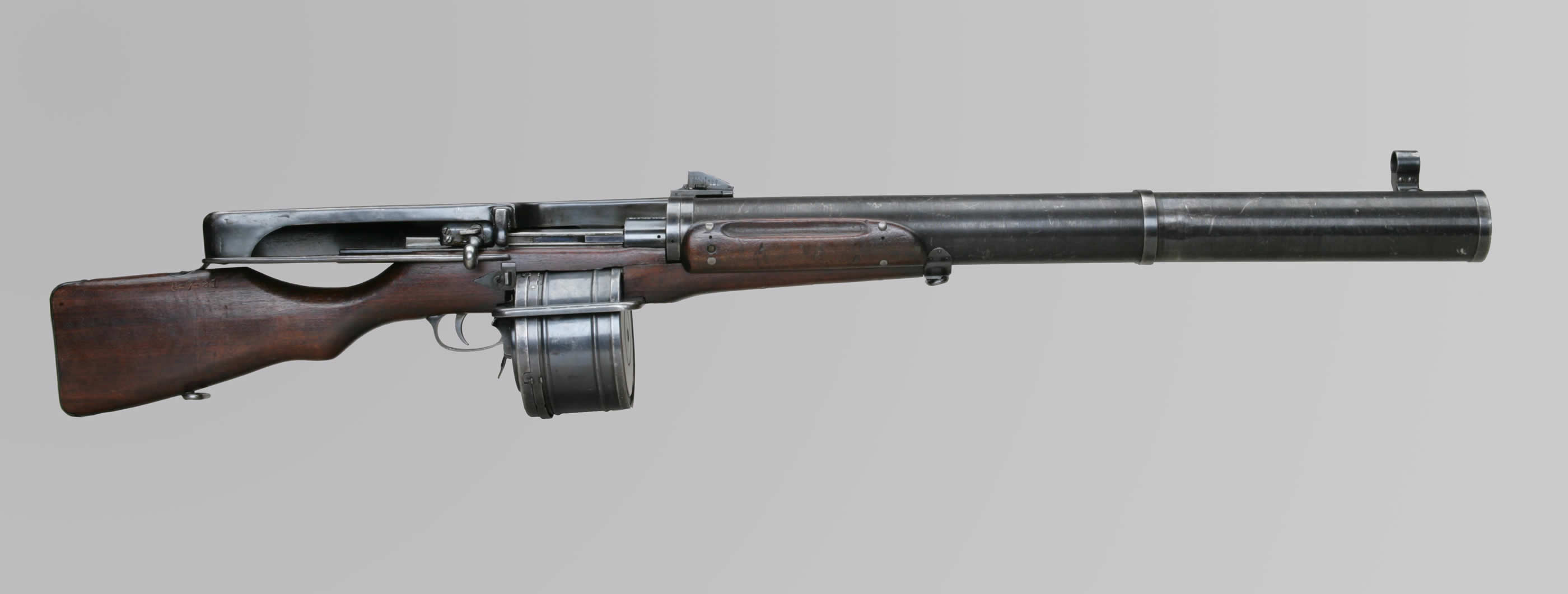
Martin Light Machine Gun (Chauchat)
The Martin Light Machine Gun was developed by Gregory Martin. It was the first handheld light machine gun to be used in warfare, seeing its debut in the First Desert War. The first models were not successful as the complicated parts often jammed or were easily broken. By the Second Desert War, newer, much better, models appeared, giving the Royal Army fantastic machine guns to use until the more favorable Wolf Automatics flooded the market. Due to their clumsy length and weight, they were never used by Sentintels, but by infanrty troops that used these to give their fellow soldiers suppressive fire. By the Third Desert War, however, there were much better light machine guns, thus it was removed from the military and sold to colonies. From the colonies, they were used by fringe colonial units until the beginning of the revolution, in which they were purchased by the Nationalists. This became the Nationalists main light machine gun.
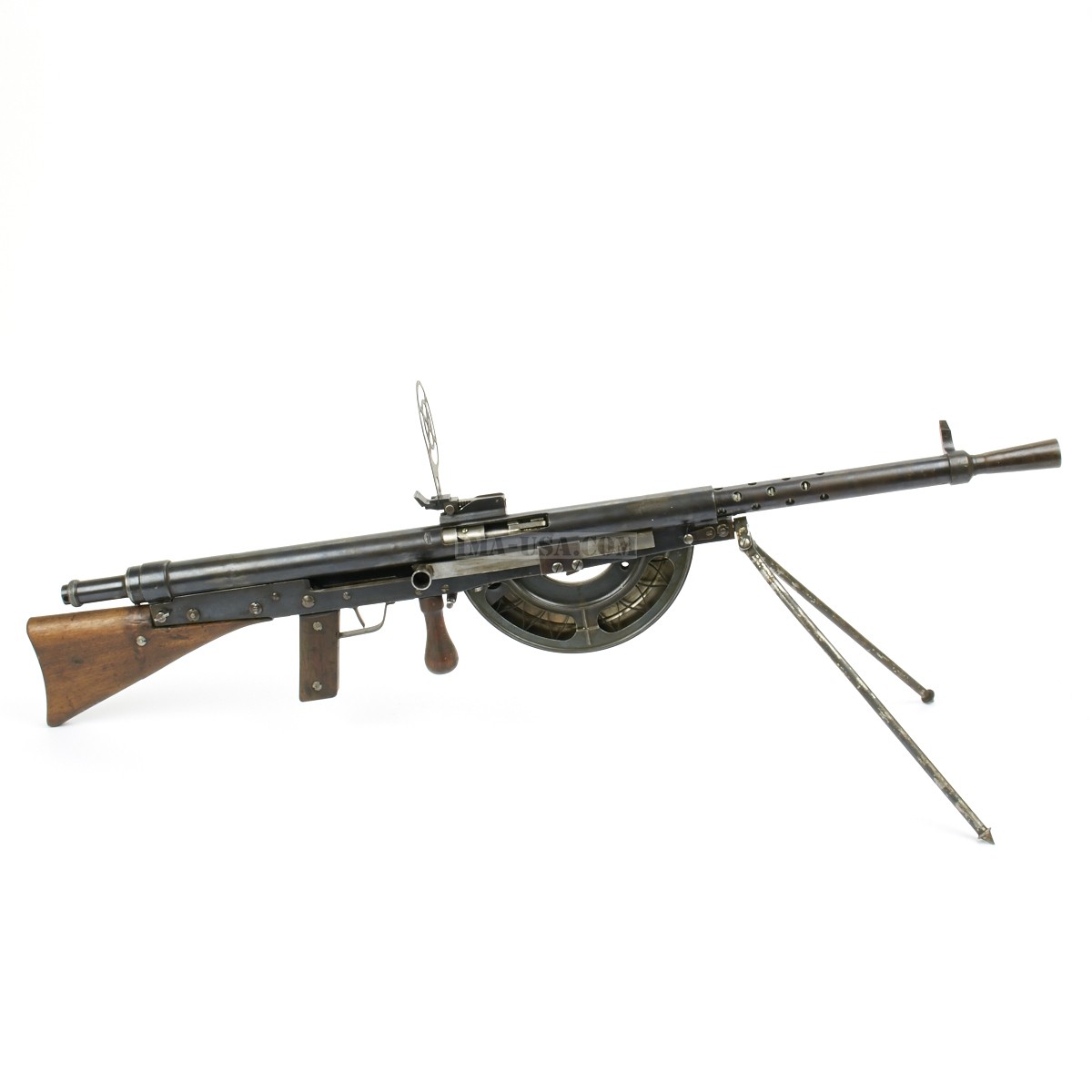
Williams Gun (Lewis Gun)
The Williams Gun was developed by Jeremy Williams and his wife from Queensport. It was first designed to be used as defensive weapons for commercial ships against the Norseland pirates. The Royal Army saw how effective it was and ordered it to be produced for the imperial forces. Williams took the offer and production for it began. The Williams Guns were often placed on tri-pods for use, but could be handled with hands alone. They were reliable and used widespread through the empire.
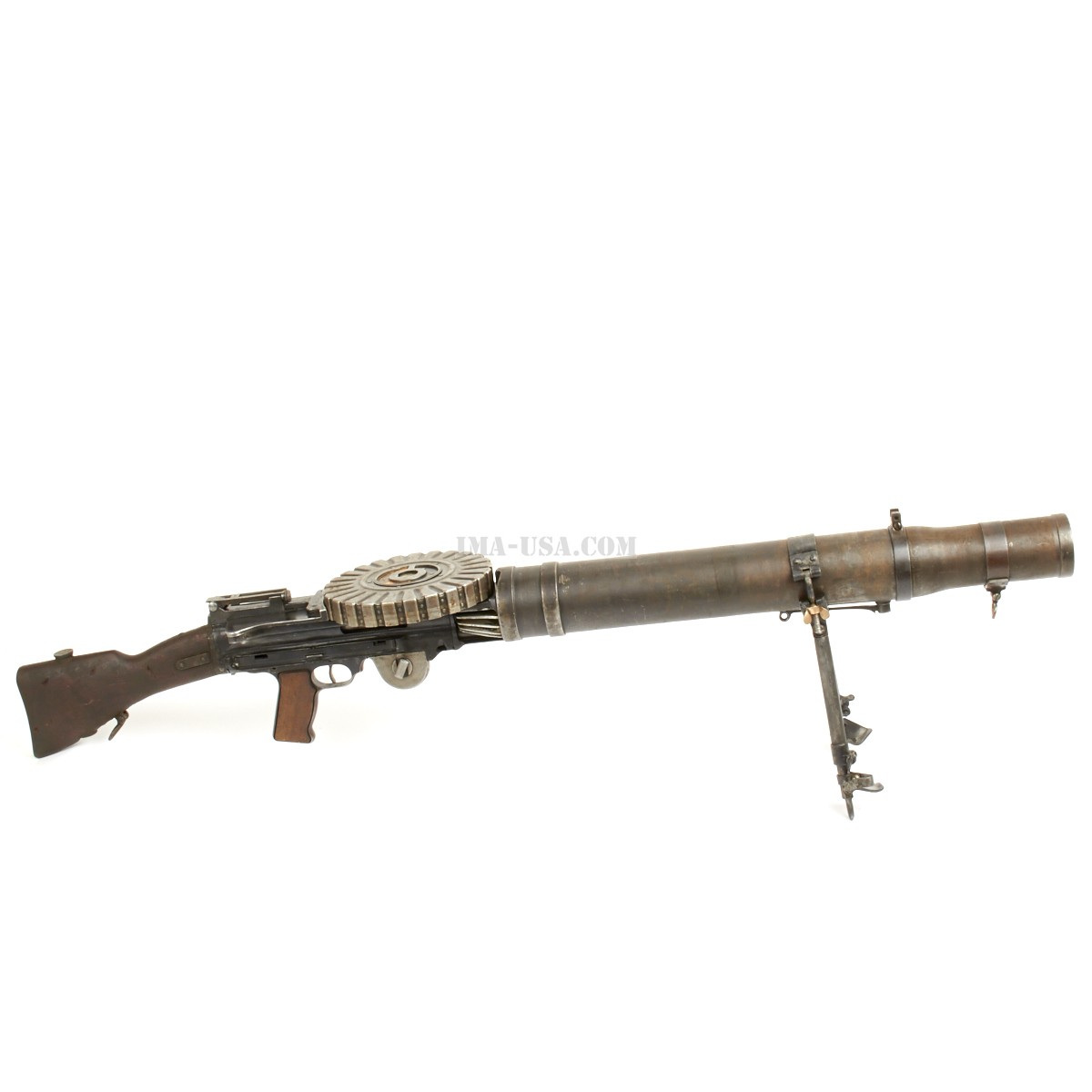
Lodona Standard Rifle (Gewehr 98)
The LSR is a bolt-action repeating rifle that became the standard rifle for Lodona forces in the First Desert War. It was not designed by either Sherwin or Nighton families, but a Heavenshire man named Albert Howardsworth. Howardsworth designed the rifle for long range combat scenarios and hunting sport. He wanted the rifle to be cheap, but extremely reliable. The first LSRs were fitted with iron sights that only began at 400 meters and went to 2000 meters. However, this was quickly changed when they saw initial combat as the battlefields were much, much closer. With the smooth bolt, the rifle could top at 48 rounds per minute. The Royal Army took it as the best bolt rifle in the world and it held up to that belief. By the revolution, it was still used by the Royal Army, but it was being beaten out by the Sherwin Automatic Rifle. Scoped versions of LSR rose in number during Desert War III, and it was a scoped LSR that Sarah Sommerset, the renowned Hallowed Sniper, used during the revolution to pick off Loyalist politicians.

Hellbringer Shock Submachine Gun (Hellriegal 1915)
To combat the Valkyrie shock troopers of the Confederacy, the Lodona military developed their own shock trooper force. Thomas Wight and Wolf Nighton helped create a submachine gun. They made the Hellbringer, a drum-magazine submachine gun that was quite heavy, but also quite accurate. They had 45-round magazines and fired at 550 rounds per minute. They were certainly ahead of their time. These submachine guns only saw use against the Confederate forces in Requiem, in which they liberated the colony for the final time until the revolution. Not many were made and the shock troopers were few in number. The shock troopers of Lodona became known as Hell Raisers after these magnificent guns.

Sherwin Automatic Rifle (Mondragon Rifle)
With the success of the LSR, the Sherwin family, most notably Royal Scientist Alexandra Sherwin, decided to try their hand at a standard rifle for the Royal Army. At the time, self-reloading weapons were becoming more prominent in the weapon society. Wanting to rid the Royal Army of single-action weapons, the Sherwins decided to create a self-reloading rifle. It took them several years and plenty of governmental investments, but they finally achieved success with the Sherwin Automatic Rifle. This rifle could fire at 250 rounds per minute, depending on one's trigger finger. It held a 20 round magazine of standard ammunition, which made them even more profitable as Lodona did not need to change its caliber from the LSR caliber. Because of its reliability and usability, it became the standard rifle for infantrymen by the time of the revolution.

Royal Guard Heavy Carbine (Lee Enfield)
Because of the Royal Guard's unique armor suits, they required unique weapons as well. With LSRs being too small for their massive gauntlets, they asked both Howardsworth and Nighton to make them a large carbine that could operate like miniature artillery. The Nighton family reluctantly helped with Albert Howardsworth to produce such a weapon. It took them 2 years to even design a bolt-action that could use massive bullets. However, they did it and created the Heavy Carbine, a weapon so fierce that it hardly needed an introduction. A large man could not carry this weapon around as it weighed 150 pounds without ammunition. It loaded 10 rounds of 20mm ammuntion, a caliber usually saved for vehicles. The first produced ones were bolt-action, but the Royal Guard found out that it was hard to operate the bolt with their armored gauntlets, thus making Nighton and Howardsworth head back to the drawing board. They simply changed the carbine to a self-reloading, which was easier due to its gigantic size. This weapon made the Royal Guard a true force to be reckon with.

Royal Dragoon Headhunter Rifle (Sharps Hankins Model Navy Rifle)
The Royal Dragoons, the main cavalry of the Royal Army, was becoming outdated by the Third Desert War. The horseriders became less and less frequent on the battlefield, being replaced by armored automobile units. However, some Dragoons simply adapted to the new warfare. They became stealth attackers, going on mile-long flank routes to surprise enemy backlines. During some missions on fringe colonies, Dragoons swept and took out rebel trading hubs by setting automobiles ablaze and picking off the leaders in quick, agile fashion. So, to keep them relevant, they needed a new weapon. A man Calvin Krissin, a nobleman from northern Lodona, was up for the task. Krissin took the designs of older navy sailor rifles and made them lighter and easier to reload. The Headhunter Rifle was born. It was a single-shot, lever-action rifle, but its large cartridge and ease in reloading helped Dragoons use it while riding. Beside the cavalry, the Headhunter rifle never took off elsewhere. It never was sold to civilians and never given to other nations. A few veterans of the wars used them for house protection during the revolution.

Royal Taylor Imperial Trench Gun (M97 Trench Gun)
First of its kind, this trench gun was not a revolver. Caroline Taylor, the much younger sister of Francis Bishop, decided to redo his trench revolver. Her design trounced his when it came out ten years later. It was more compact, less likely to get dirty, and much more reliable. At first, the Royal Army did not see use in the trench gun, as they already were biased against trench guns. They issued 15 Imperial Trench Guns to the troops in the Second Desert War. They were used successfully and the generals saw an opportunity to use them for charges at the Republican trenches. This was when Taylor's gun took off and became the standard trench gun for the Royal Army. It also became a commerical success to colonies and civilians. So both the Nationalists and the Royal Army used these guns in the revolution.
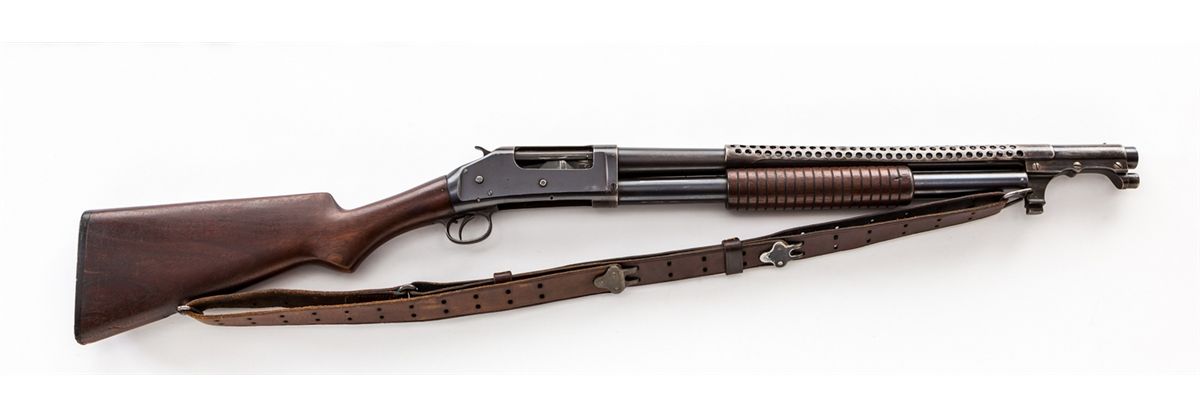
Royal Decree Sidearm (P08)
These pistols were designed by the Sherwin family. There was a very similar pistol designed by the Bishops that led to legal claims on who designed it first. It is still not certain, but the Justice Department gave the Sherwin family the credit, much to the Bishop's dismay. This sidearm was only commonly used by the Royals. It carried 8 pistol rounds and fired at a high rate. It was nicknamed "Toy Guns" by the common people as nobles who possessed them seemed proud of their little pistols and would carry them in plain sight as a symbol of wealth rather than a warning. It was however, almost ironic that these pistols were cheaply made and used cheap parts but were sold at great prices. More common pistols and revolvers fared better than these pistols but were frowned upon by the Royals for simply not being a great RDS pistol. Nobles learned the hard truth when the revolution started and Nationalist pistols outdueled the Toy Guns.
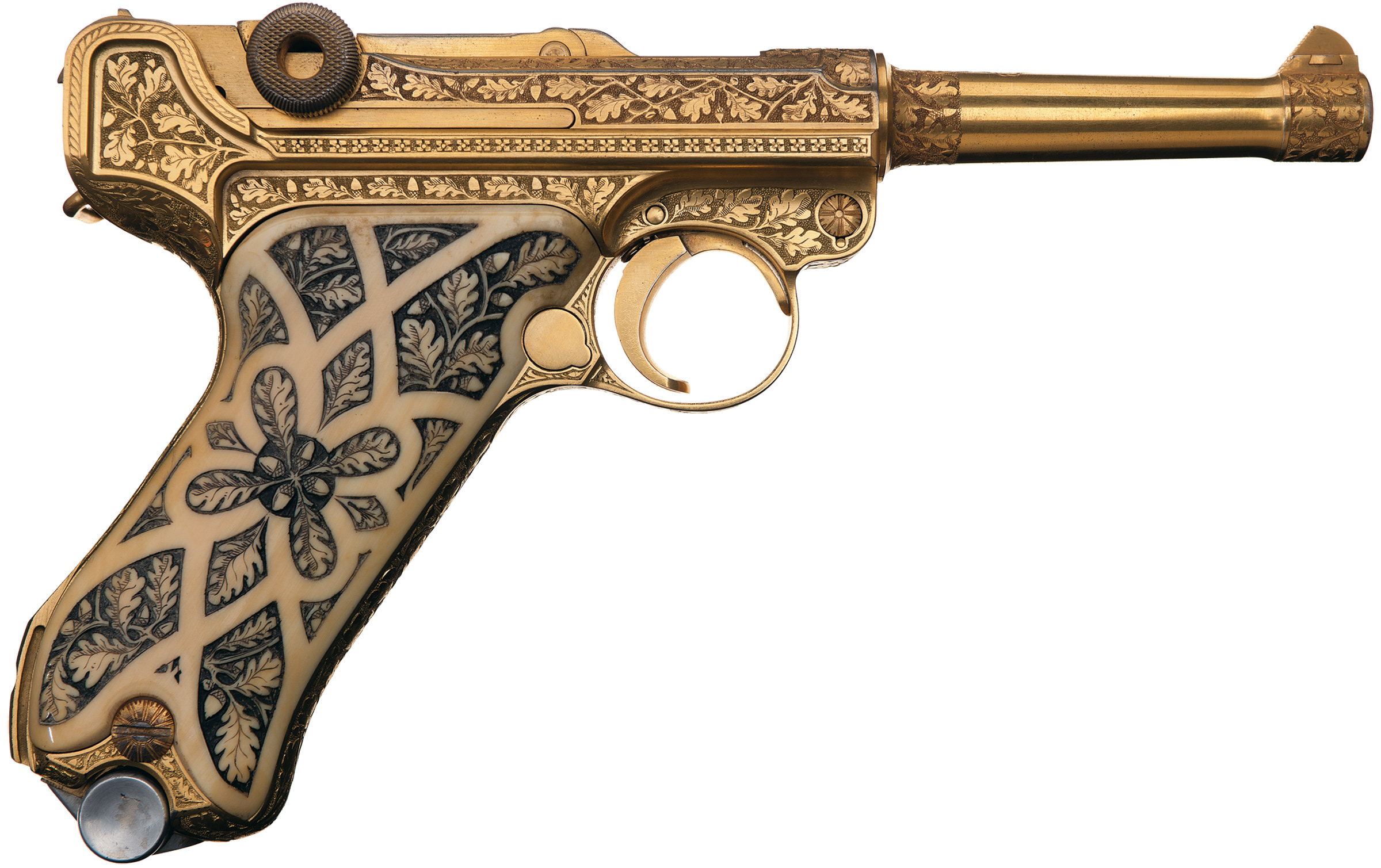
B-66 Automatic Pistol (Mars Auto)
The B-66 was a large cailber pistol designed by Royal Engineer Harry Bishop. He designed these pistols to be issued to tankers that operated in BAPTs. Since light tanks were often incredibly tight inside, they needed a small weapon with lots of stopping power. This pistol weighs 12 pounds and holds 12 rounds of rifle-size ammunition. Tankers were trained to hold B-66s with two hands before firing, as the kickback could injure an unsuspecting wrist. The Royal Army loved them and issued them to tankers as well as Sentinels. Upon seeing the success, the Royal Guards ordered an even large version to be made for them. Bishop did so and created the B-70 version, which used very large caliber rounds that could only be used by Royal Guard armored suits.
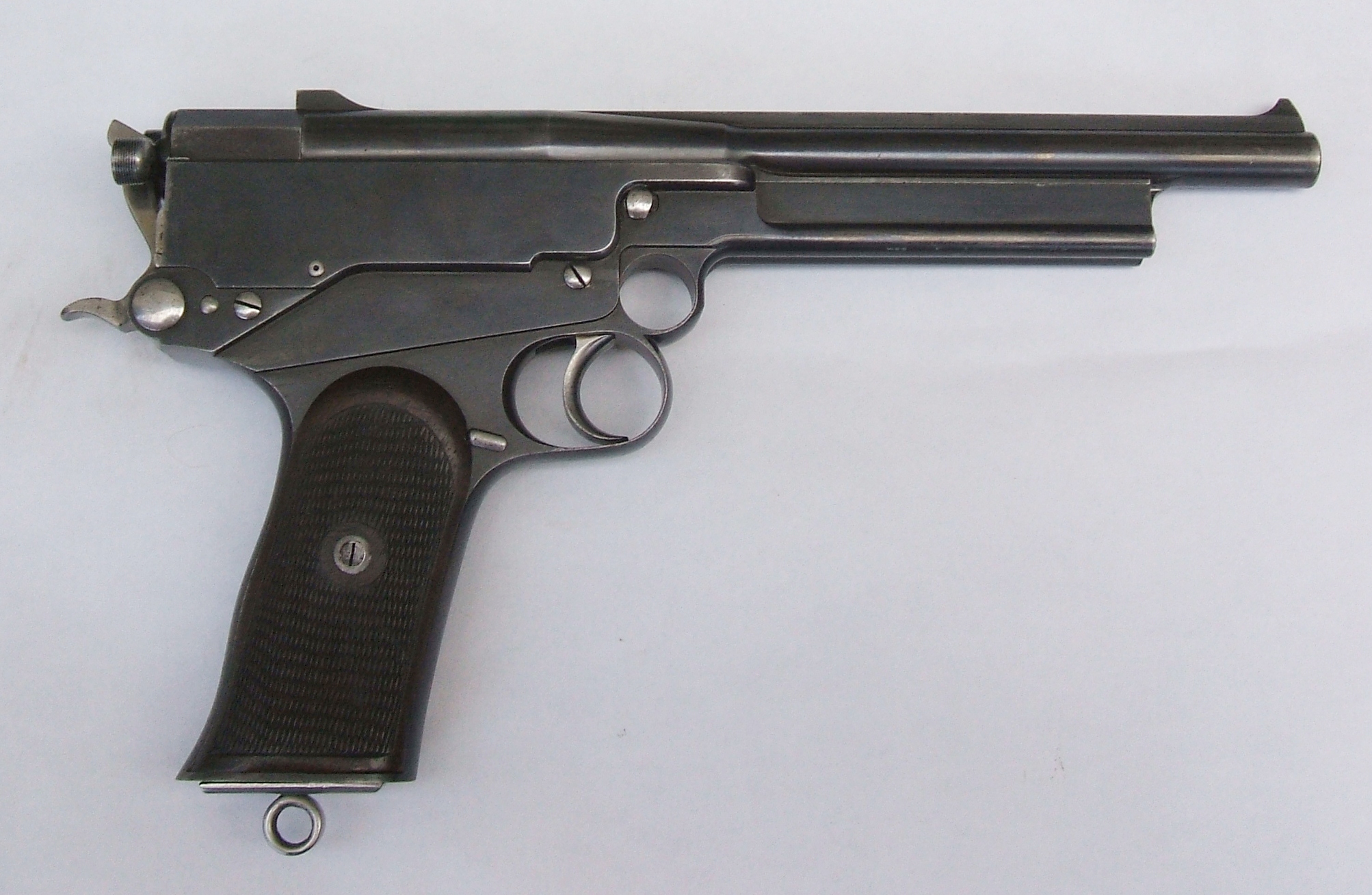
Sherwin Heavy Revolver (Carhone Revolver)
The Sherwins, after their mediocre sales of the Royal Decree, began looking at pistol designs by other manufacturers. They came across the Bishop Trench Revolver design and decided to use it to create a 20-shooter pistol. This became the Heavy Revolver that held large caliber rounds in a massive revolver pistol. This gun weighed 9 pounds fully loaded. Because of its size, it was not issued to normal infantry as it was painful to carry around with other supplies. So this weapon became an officer's signature. High-ranking officers would carry them around and could use both hands to operate them. It was a man's true weapon of war. Though it did not possess the dainty qualities of the Royal Decree, this gun held its own for brutality alone. Unlike the nobles who wished their weapons to look the part, the Royal Officers and commanders only cared for functionality. This revolver was quite functional.
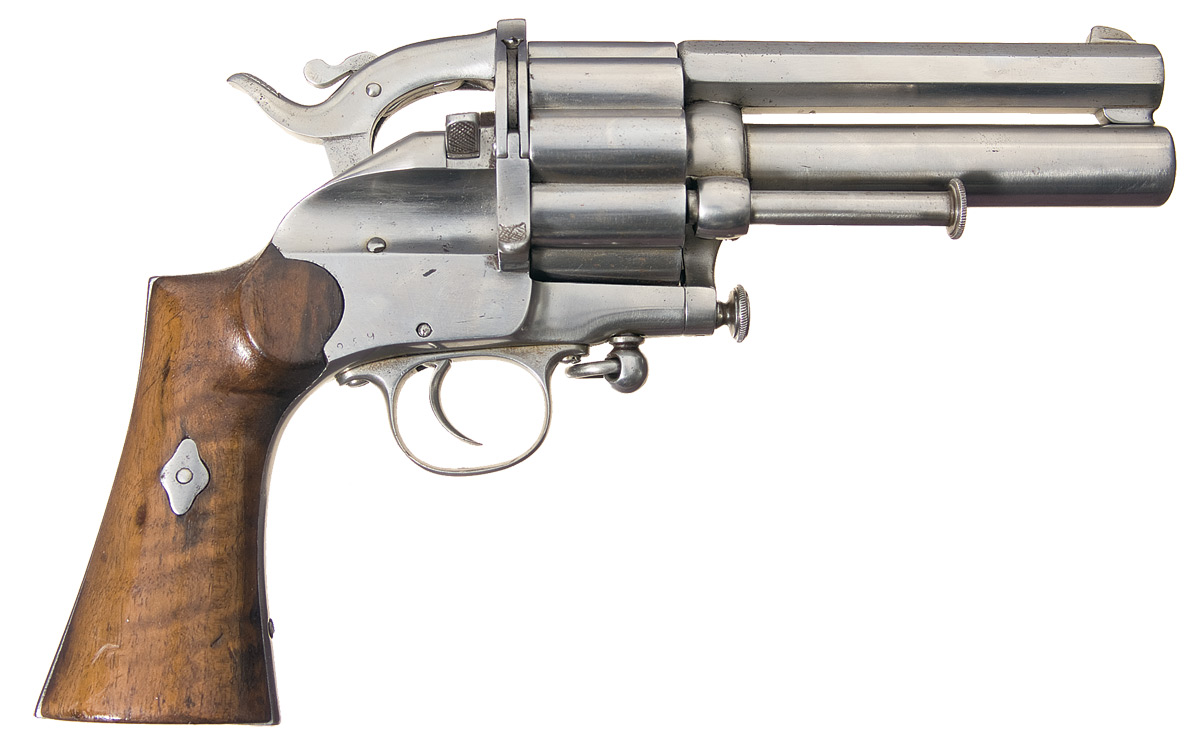
Wolf Automatic Pistol (C-96)
This was one of the finest pistols ever made. Though not the first automatic pistol in Lodona, it was certainly the best. Royal Engineer Wolf Nighton designed these pistols to be the standard sidearm in the Royal Army. He had created the designs long before he was appointed Royal Engineer. It was an instant success as it passed all its tests with amazing reliability and accuracy. It was mass produced in the Lodona factories and by the end of the Third Desert War, it was the standard pistol of infantrymen. It was also a success in Anastasia as Royal Officers and noblemen purchased them. Though not as stylish as the Royal Decree, it was an all-round much better pistol. Master Bell, Elysia's father, possessed one of these fine specimens.
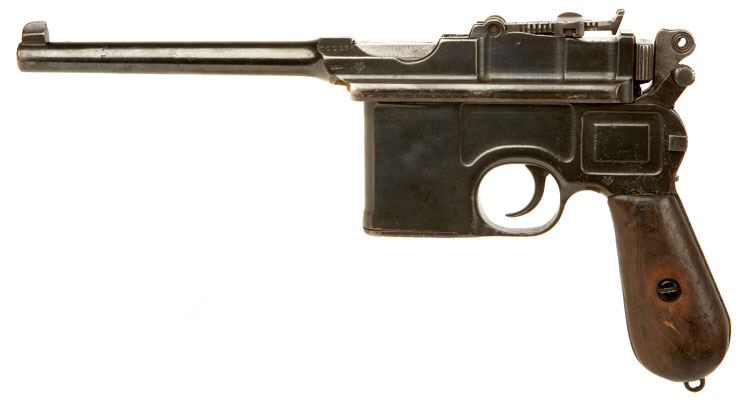
Heavenshire Revolver (No. 3 Revolver)
This revolver was made for cavalry units during the Colonial Wars. It was not designed by the reigning weapon families, but by a group of women in Heavenshire named the "Heavenshire Angels." The Angels designed these revolvers to be light-weight and quick to reload. Unlike previous revolvers at the time, these did not need percussion caps, thus taking a tedious step out of the reloading cycle. This fact alone made them a trusted sidearm in the Royal Cavalry. As time went on, they became less used as when Desert War I arrived, warfare had changed drastically. Revolvers became replaced with self-loading pistols, making these revolvers be sold in surplus to the Lodona citizens. As they were too "military" for purchase in Anastasia, they were mostly bought by Lodona countrymen. However, some merchant families did buy them. One merchant sold his revolver to a young Hondo Bell. Master Bell then gave this gun to his daughter Elysia, to use during the revolution.

Broadbrook Turret Repeater (Porter Turret Revolver Rifle)
William Broadbrook, a member of the Meadowland Arsenal Co. invented the "turret revolver." This was an odd concept as the usual parallel barrels were coming into play at the same time. However, what made this gun not rejected on the spot was how much it could hold, which is 16 rounds that could be fired in quick succession. Not only that, it was more accurate than the competing weapons. Using a lever, one could rotate the turret like a crank. So in a way, it operated like a lever-action rifle, but could hold twice as much ammunition. The only issue was that it was difficult to reload and the rotating mechanism could be easily damage with slight misuse. They did not prosper in the Royal Army and were instead sold to other imperial countries. The Nationalists obtained some of these repeaters, but preferred using other more modern weapons.

Requiem Bloodhound Pistol (Bergmann No. 5)
The Lodona colony of Requiem, a mostly valley colony that rested on the border between the Norseland Confederacy and the motherland of the Lodona Empire, shared in many small wars. Five times they were conquered by the Valkyries of the Confederacy and five times they were retrieved by the Royal Sentinels of Lodona. Requeim was home to several factories, of which a couple created weapons. One company that was stationed there was Bloodhound Armory. Edward McBaine financed this company for several years. They made their own unique pistols, which they used twice against the Norseland armies. They were not effective and many were destroyed in battle. The surviving ones were thrown to McBaine to use, which he did. When the revoultion began, he distributed the ones he had to the Nationalists and Unionists.
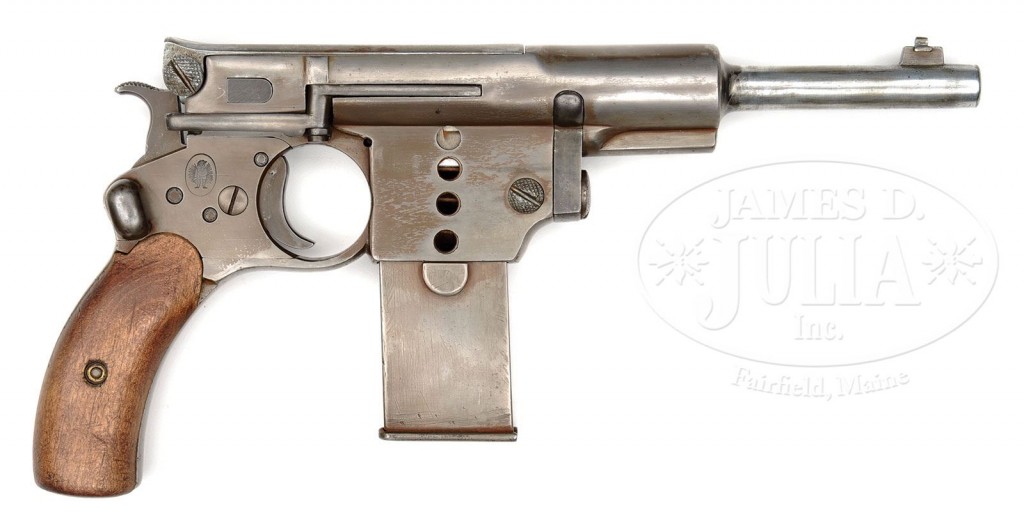
Queen Lauren Breech Rifle (Martini Henry)
This rifle was used by the Royal Army in the Colonial Wars. Being a high-caliber single-shot rifle, these weapons were easily mass-produced by the Lodona factories. Shockingly, it idea for such a rifle was conceived by a Royal Maid, Elizabeth Allsworth, who served Queen Lauren the Victor. In testings with other rifles, the Royal Engineers at the time were stumped on how to make it easier to reload single-shot weapons. Miss Allsworth famously said "Why not stick the bullet through the ass?" and that led to the invention of the breech-loading rifle. Queen Lauren was the first to fire this weapon, which led to its name as the Queen Lauren's Rifle. It is by far the most produced rifle in Lodona, still being used by militants at the time of the revolution, which took place 70 years since Miss Allsworth said that famous suggestion. Famous individuals used these rifles such as Queen Lauren and the more recent Charles Valentine, who used his father's rifle.

Nationalist Mabry Ordnance Lever Rifle (Russian 1895)
Jonathan Mabry, a former Royal Engineer, had these guns in stock even before the end of the Third Desert War. Because of a business failure and unpopular position with the Royals, Mabry could not get his guns sold. The Royal Army felt his lever-action rifles were outdated and even though they could easily be mass-produced, they were so ineffective that LSRs would still be better. With thousands of these rifles and no one to sell them to, Mabry was thrown out of the Royal Engineers. He became a recluse until he was contacted by Edward McBaine five years before the start of the revolution. McBaine offered to purchase his useless rifles. Mabry accepted even though the price was abysmal. With almost paying nothing, McBaine was now in possession of thousands of these rifles. By that time, McBaine was already anticipating a civil war in Lodona and so he kept them until the Nationalist Party came knocking on his door. He sold every one of the rifles to Valentine's forces across the entire country. To the Nationalists who never owned guns, these were the first weapons of war they ever used. Over 50,000 of these rifles were given to Nationalist troops, making it the most widely used weapon on the rebel's side, earning its name as the "Nationalist Ordnance Rifle."

Unionist's Secret Weapon: Garner Automatic (Springfield 1903 + Penderson Device)
Sabrina Garner, the leader of the Unionist Party after taking it by force from Isaac Benjamin, decided to make the Unionists an ally against the Loyalists in the revolution. Having most of the factories under her control, she decided to keep the workers in them to create a "secret weapon" that would make them win the war. With her own money, she hired Kendrick Loft to design a device that could turn bolt-action rifles to semiautomatic death machines. Being the genius he was, Loft did not disappoint and designed the Secret Weapon. However, he made the mistake of making the device unable to be used with LSRs or other popular bolt-action rifles. Thus he designed his own rifle based off of LSRs and Lady Garner named the weapon after herself, despite not helping at all with it. This made Garner Rifles actually not bolt-action at all and only appeared like one. They shot pistol cartridges in 40 round magazines. Because of all the mishaps, the Unionists tried to mass produce them, but could not. And along with the Royal Army preventing any metal from reaching them, they barely made enough to supply their small forces. It was announced a failure by Isaac Benjamin, but these weapons did see plenty of combat.
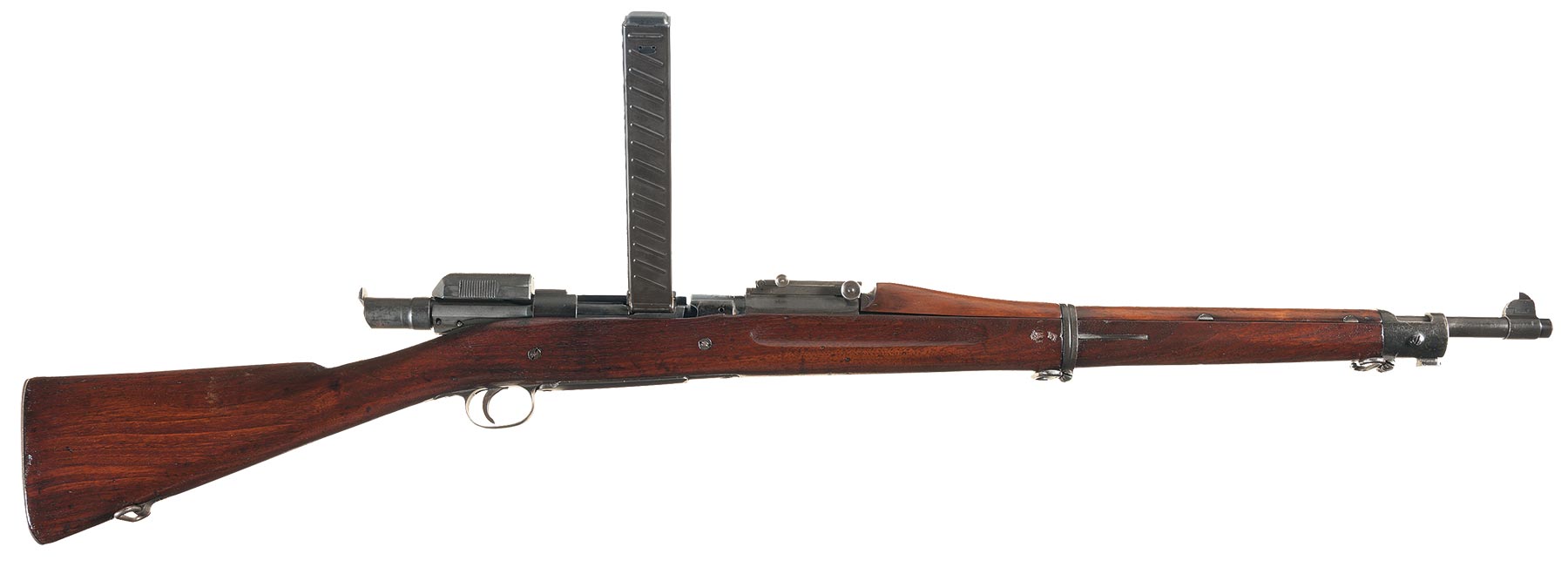
Republican People's Rifle (Arisaka Type 30)
The standard rifle for the People's Army was the People's Rifle. It was a simple bolt-action rifle that was very similar to the LSR, but longer and with a slightly larger cartridge. They were far less accurate than the LSR, but they were much cheaper and just as reliable. Because of the massive amounts of infantry in the People's Army, this rifle became the most produced rifle in the world. It was also the first rifle able to use special Heat Bullets that would explode on contact with armored surfaces. Because of its similarities to the LSR, Lodonans believed that it was the LSR and that the People's Army was simply using their weapons against them. To the trained eye, the differences could easily be seen, but to everyone else in Lodona, it was believed that only Lodona technology could keep the People's Army from buckling under Royal might, which was simply not the case.

Republican Iron Hand Automatic Rifle (Madsen 1896 Rifle)
The Iron Samurai of the Eastern Republics were mostly known for their long swords that they would use to slash through infantry, but they were not so primitive. Much like the Heavy Carbines of the Royal Guard, the Iron Samurai also had their own unique rifles that were larger than the rifles used by regular infantry. The Iron Samurai used Iron Hand Automatics terrorize enemies from afar. Nowhere near as big as the Heavy Carbines, these rifles still used large caliber rounds that fired at tremendous velocities, giving them a slight ability to pierce armor. They, like the People's Rifle, were able to use special Heat Bullets to hit armored vehicles. They were more expensive to create, so they were only made when needed and no excess was ever found.

Republican A-30 Long Rifle
These rifles were developed by a group of mechanical engineers in the Eastern Republics. It was designed with the goal of issuing these rifles as standard rifles for the People's Army. It did well in tests, but its small magazine and tight bolt made it impossible to use in real combat outside of sniper situations. So the People's Army instead gave it to special forces that would operate on the mountains in the Desert Wars. However, they had many more rifles than special forces. So the Eastern Republics gave the rest to any who would but them. Mostly civilians of the Eastern Republics did, but a few made their way into Lodona. Because of their fancy finish, those who bought them did not really use them as they also could not get the foreign ammunition cheaply. During the revolution, rich merchants on both sides used these rifles, believing they could snipe well, but never hit anything and ran out of the precious ammunition, making these rifles useless.

Republican Destroyer Rifle (Tankgewehr)
The RDR was a rifle made in response to the massive mechanization of the Lodona Empire in the Desert Wars. The People's Army, which was in the progress of mechanizing themselves, needed a way to defend their brigades from the onslaught of tanks and armored cars. Their genius engineers designed the Destroyer Rifle which fired explosive rounds that could easily penetrate armor plating. Because of their expensive qualities such as size and ammo, these rifles were given to specialized "Tank Destroyer" units. With these rifles now in the hands of Republican marksmen, Lodona forces started to use less straight attack approaches with armored vehicles, as the RDRs would devastate them. During Desert War II, Royal forces captured a RDR and recreated them for use against the now mechanized Republics.

Republican Guardian Sidearm (Bergmann 1896)
The Guardians, a military branch of the People's Army that used guerrilla warfare, had these weapons as their standard sidearms. They were heavy pistols that used large caliber rounds. They began use in the Desert War II when the Royal Army of Lodona pushed through Republican territory. The Guardians hid in the desert sands with these reliable pistols and could target officers in the back lines. These were the only Republican tools they used as they often would use Lodona-made weapons that they had seized from the ravaging imperialists. It became such a fearful weapon that the Royal Army dubbed it "the Bulldog."
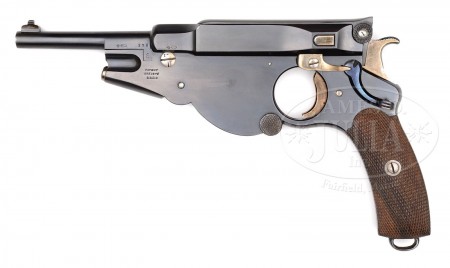
Norseland Kirkstrive Sidearm (Howdah Pistol)
The Norseland Confederacy were known for their large weapons, even for the pistols. Kirkstrive, an uncle of one of the Seven Lords, designed this pistol for the officials of the Confederacy to use. However, with the testings, the Army was interested in them as well for the battle officers and artillery operators. So this 4-barrel pistol was heavily used in Norseland combat by both infantry and artillery. It was one of the standard pistols of the Army of the Seven Lords. It was reliable, it was unique, it was perfect for the might of the Norseland forces.
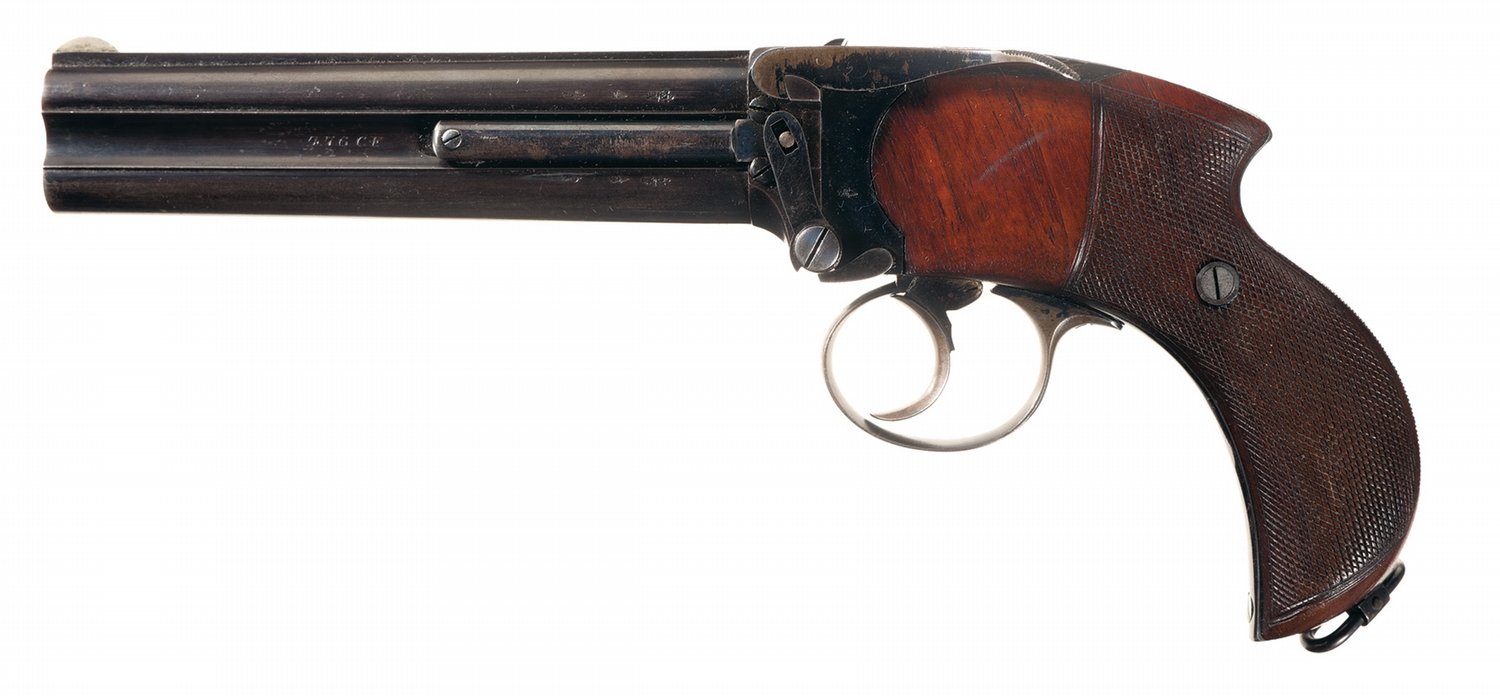
Confederate Ragnarok Rifle (Selbstlader 1906)
The Northern Confederacy, also known as the Norselands, possessed an arms company called Ragnarok. Ragnarok developed a standard rifle for their massive military. Seeing competitor pistol designs, Rangaronk found out of to transfer the automatic qualities of pistols to rifles. The CRR was the result of this. The CRR only held five rounds, but could be shot quickly and accurately. Being one of the first automatic rifles in existence, it helped the Confederacy retain its borders from other imperial nations, including Lodona. It became the signature weapon of the Confederate Raiders and the armored women brigades called Valkyries. In many ways, this weapon became more famous than those who created it. By the time of the revolution, the Norselands still had this rifle as the standard military weapon and adjusted it so that it could 10 rounds. Edward McBaine purcahsed the outdated 5-round rifles from the Confederacy, who were excited to see their southern rival for world domination fall by their own people.

Confederate "Valkyrie's Kiss" Huntress Submachine Gun (Villar-Perosa)
The Norseland Confederacy was the first nation to create submachine guns. As the world was turning to planted machine guns, the Norseland engineers were forced to go along with them. They developed the Norseland Gunner, a two-barrel machine gun that had to be mounted before use. They made them using only 25-round magazines, which made reloading them a constant, unlike the belt-fed machine guns of the Royal Army. The Seven Lords told them to change it, make it hand-held, and give it to the Valkyrie forces. They did exactly this, creating the Huntress "submachine gun." Valkyries were able to use these weapons in the mountains against Lodona forces. Because of their expensive tendencies, these guns were rare and only seen being used by special shocktrooper Valkyries.
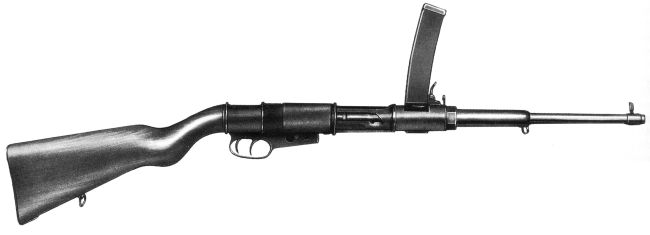
Norseland Portable Artillery (AT Rocket Gun)
This anti-armor hand cannon was one of the first anti-armor guns ever made. The constant skirmishes with the Lodona vehicles made the Norseland Confederacy adapt by creating a weapon to combat with the mechanical beasts of the mountaintops. This adaptation was the NPA cannon. The NPA was a primitive anti-tank weapon that had to be set up on a tripod before being fired effectively. In the mountains, Valkyries would set them up on high points and fire shell after shell at enemy vehicles before picking it back up and fleeing from inevitable retaliation. It became standard for Valkyries to be trained with these weapons as the mechanized warfare increased the demand for these types of artillery. The Nationalist acquired only a few of these and the Royal Army actually started to use captured ones against the Nationalist armored automobiles.
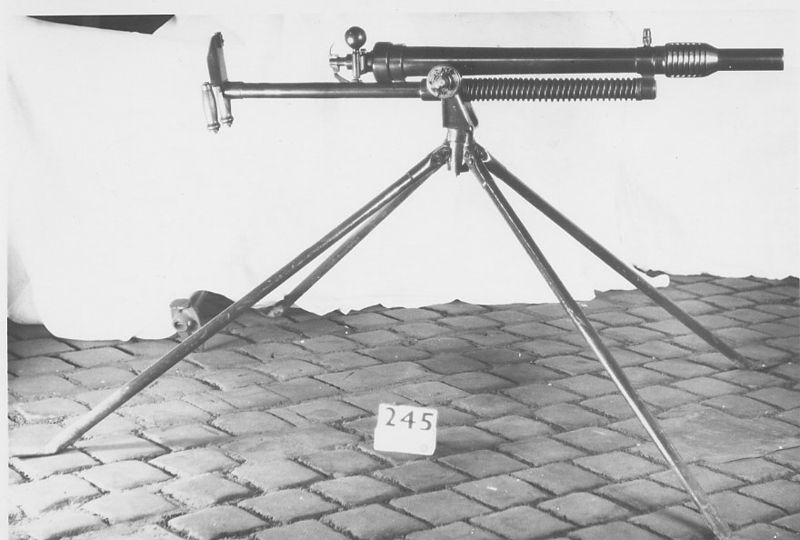
Wastelander Arklight Pistol (Frommer 1901)
In the Desert Wars, there were two main combatants: Lodona and the Eastern Republics. However, there was a third faction: The Wastelanders. The Wastelanders were the people that inhabited the Dread Deserts. Often thought as crude and uncivilized, the Wasterlanders were quite advanced for not being a imperial nation. By being the owners of oil and diamonds, their small borderless "nation" grew and prospered. Their leader, Abigail "Sandy" Arklight, a Lodona-born businesswoman, was the first person to really push the trade between the Wastelanders and the empires. She contacted the Republics and Lodona, setting up trade of oil and diamonds for steel and wood. She knew from the beginning that the Dread Deserts would be a place of constant war as it held so many precious resources for the hyper-industrialized world. So she started the Wastelander Scout program, in which she hired mercenaries to train a Wastelander military and she purchased weapons to arm them. They purchased weapons from the Norselands, Lodona, and the Republics. She also developed the first Wastelander original pistol: the Arklight Pistol. It was never sold to other countries and became the signature weapon of the Wastelander Scouts. It was not the best pistol, but it was reliable in the desert sands.
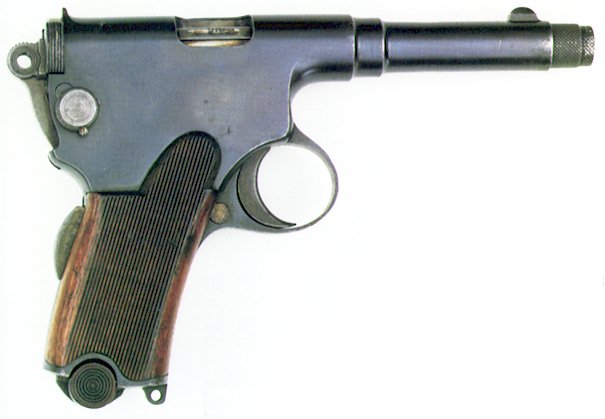
Sallian Oceania Self-loading Long Rifle (RSC-17)
The small coastal nation of Sallia, a place that was rarely seen warfare due to constant neutrality, hardly deals in weapons of war, but do have a few. Antonio Belgetti, a weapons designer from Sallia, created the Sallia standard issue rifle for their small, but resilient military. Eight years before the revolution, Sallia was still using bolt-action rifles as their main tools of defense. With tensions rising in Lodona, the country feared that if Lodona were to fall, they would have to defend themselves against the now freed colonies that crept on their western borders. Belgetti was commanded by the Sallian government to bring them up to Lodona's technology. He did that in a surprisingly small amount of time. He created the Oceania Self-loading rifle, named after the manufacturing company he worked for, Oceania. It held five rounds, using LSR ammunition, and was reloaded from the bottom instead of the top, like most rifles at the time. 30,000 were made, one for each of the Sallian Vanguard. It was a mighty success and Belgetti was honored with a Knighthood. The Vanguard used this throughout the conflicts of their imperial neighbor.

Sallian Oceania Automatic Sidearm (Salvator Dormus)
The Vanguard, the national guard of Sallia, were the only militants in the small trading nation. Their main task was to guard the Sallian Royal Family. They used a standard, iconic pistol designed by Lorenzo Masentti during Lodona's conquest of their former neighboring countries. When Sallia signed peace with Lodona, the imperial nation allowed them to create their own military if only it would never leave their borders. Sallia agreed and the Vanguard was made. Masentti designed the pistol to not only have great stopping power, but also be automatic, a rarity at the time. It was a success and Oceania produced the pistols for every Vanguard soldier. It was an old gun, but new changes were added to keep it smooth and reliable against the powerful nations that were fighting for every inch of the planet.
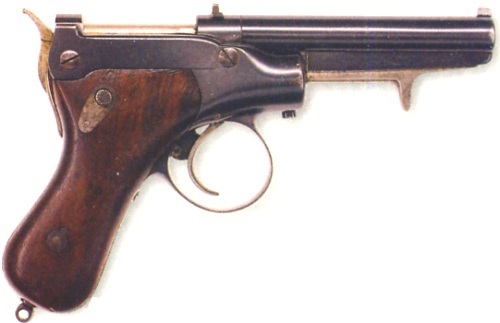
Makri Sidewinder Machine Guns (Thompson Annihilator)
The Makri, an imperialistic nation that held very remote colonies, were a mostly defensive force against the ever-growing Lodona Empire. Of the major imperial nations, they were not the most advanced, however, they did possess several clever weapons that kept them from falling to more powerful empires. The most significant of these was the Sidewinder. The Sidewinder was an automatic rifle that fired at 400 rounds per minute, but was too large to be classed as a submachine gun. It was an odd design and a unique design. It was reliable and worthy of the title, but with its expensive qualities, there were not many of these made. They were given to Makri Striders, who patrolled the borders of their homeland, picking off any foreigners who dared to come into sight. The Royal Army greatly disliked these weapons, but made no haste to copy the technology. It was evident that they could make something better in due time.
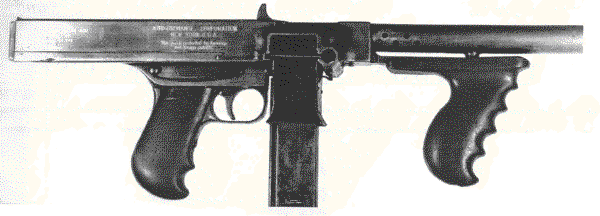
Makri Fury Rifle (General Liu Rifle)
The Makri were not the most advanced imperial country, but the Fury Rifle was their biggest accomplishment in terms of military prowess. The Fury Rifle is an automatic, 5-round magazine, standard rifle that was used by all military branches of the Makri. It was more expensive to make as the Makri did not have as many factories as Lodona or the Republics, but their army was also smaller, so they did not need to create as many anyway. This weapon was the Makri's biggest seller as well, being bought by the Eastern Republics during the Third Desert War. So many were purchased, the Makri were scared that the Eastern Republics would simply buy-out the defenses of their homeland, so in the last year of the war, the Makri pulled the weapons from the market. With the Lodona Army holding the Dread Desert successfully, the Makri thought it was only a matter of time before the imperial beast would turn her flaming eyes towards them.
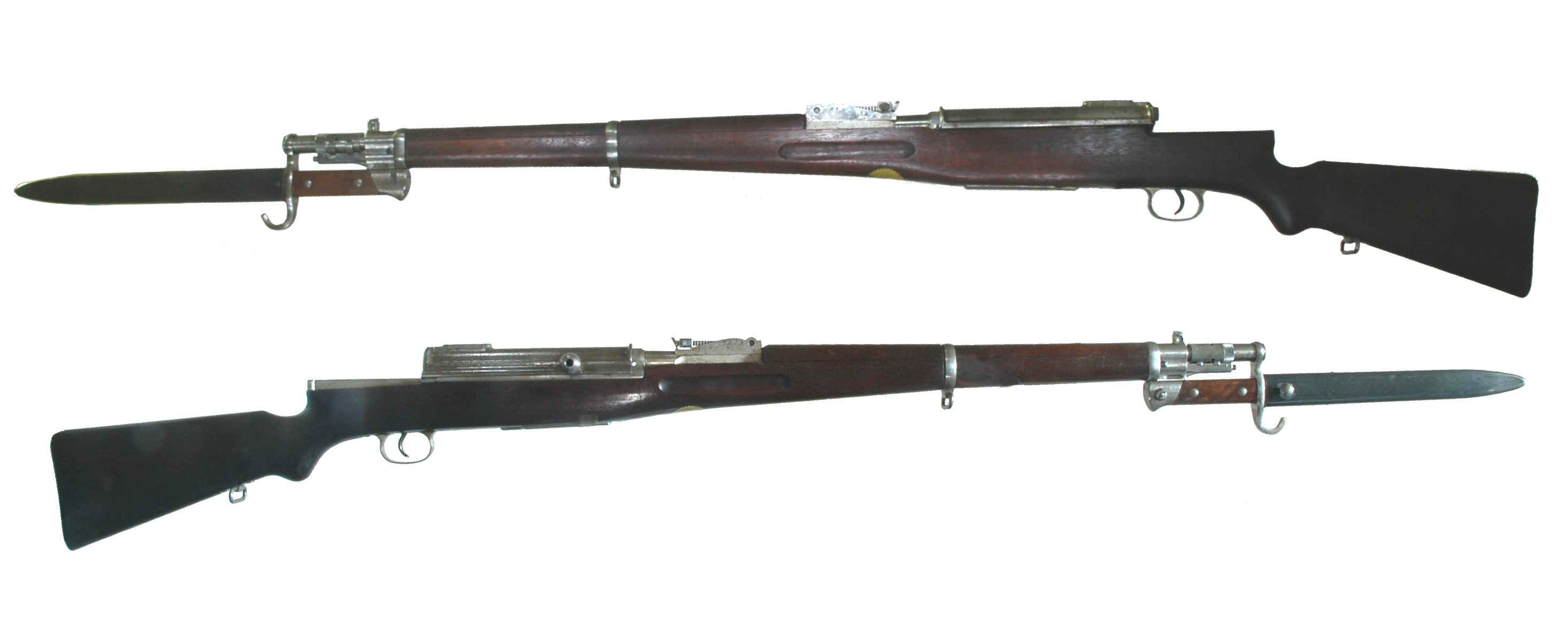
Makri Deliverer Pistol (Glisenti 1910)
One of the most prominent of Makri engineering, the Deliverer pistol was designed for the Jurrits, a mysterious class of Makri military officer. These pistols were never in prestine condition, as they struggled in the sandy deserts the Makri called home. However, it did serve its purpose as a sidearm, being more famous for its appearance than its effectiveness. It became a prominent symbol of the Makri, especially since finding other symbols of the shrouded nation was hard to come by. Western Lodonans knew the shape and high pitched shriek of the Deliverer pistols, so their stories spread eastward to the more populated side of the imperial nation. By the time the stories passed orally to Anastasia, the rumors and horror tales made the Deliverer pistol much more menacing than it ever was.
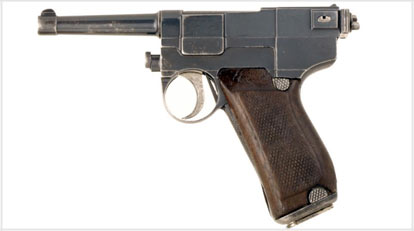
Types of Military Concepts
At the time of the revolution, Lodona was a prestigious empire with a constantly-conquering military behind all its successes. Before Lodona was an imperialist state, the military only served as a defense force as Lodona lacked the resources to go and seek colonies like some of its neighboring nations. After the Fated War almost 100 years before the revolution, Lodona became bent on becoming the leader of the world. Factories and the military grew exponentially with each following year. The empire gained colonies and effectively swallowed its neighboring imperialists. Because of this, Lodona has a complex military full of positions and reasons for its existence. When the Era of Industry arrived, the Royal Army became just a side to the military, now including motorized vehicles and planes and airships.
The Royal Guard
The Royal Guard were formed by Guardsman Cornwallis just years before the Sacking of the First Anastasia. Cornwallis wanted an elite force specifically assigned to the protection of Lodona's finest cities. He also wanted them to be separate from the Royal Army and not under the command of generals, but of the Royal Iudex and the Royal Family. During their early years, Royal Guards were nothing more than well-groomed and fashionable soldiers. After the Sacking, they became something different entirely. After the Sacking, in which Guardsman Cornwallis was killed, the Royal Iudex demanded to make the Royal Guard the most feared defense force in the world. Ten years later, they found out how they would do it. Edward Nighton, the most famous of the Nighton clan, invented a sort of armored suit that was tough enough to deflect bullets and light enough for soldiers to wear. Nighton wished for these armored suits to be used on the front lines, but when men who wore these suits fought in open war conflict, they were often blown away by artillery and lacked the movement capabilities to last with marching infantry. Thus, the suits were moved to home defense. There, Nighton continued his research and added features to the armor, making them more effective and easier to use. The Royal Iudex told him they wanted the suits to be used for the Royal Guard. Without much choice, he accepted. What came to be was the Nighton Steam Knight Suit. Not only did these suits possess hydraulics to help users lift heavier objects, it made them almost completely bullet-proof and slightly anti-explosion proof. These suits made the Royal Guard the most intimidating faction of war. They could not move as fast as unarmored infantry, but they didn't need to.
The Royal Guard use their own ranks and ranks do not crossover to the Royal Army. They are absolutely loyal to the Royal Iudex and the Royal Family. They have the ability to arrest citizens much like the Royal Constables. They often investigate crime in relation to the Royals. This made them unpopular with the normal folk as they appeared to be oppressive soldiers that brutally kept the peace. Although many could argue that this is not the case as they rarely arrested people and were more known for keeping the Royals safe from harm.
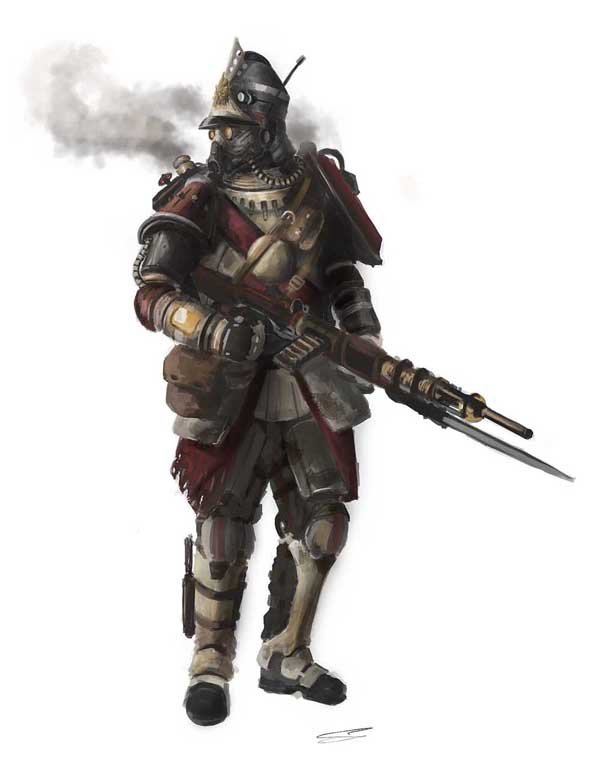
The Royal Army
During the Era of Industry, Lodona was the most powerful military might in the world, followed closely by the Norseland Confederacy. The Royal Army, at this time, was on every continent, defending colonies or taking new ones for the ceaseless empire. They were a diverse army that took recruits from colonies.
Every Royal Army branch did not allow women to enter unless they were sentenced. One unique law for Lodona was that they could sentence tried criminals to enter the Royal Army and be in it until their sentence was over. If often quartered jail sentence lengths, but also greatly increased the likelihood that the sentence would not be served in total due to premature death. This was the only way women could enter the Royal Army. With only 2 weeks of training, criminals were then sent to the front lines as infantry and unable to gain any ranks, no matter the quality of service. It was not a particularly odd sight to see chained men and women being stuffed in military transports. In fact, when people did see this sort of thing, they often cheered as they knew the ruffians would be likely never to return. In fact, the mortality of sentenced soldiers was over 90%! It became part of criminal soldier training for them to not die like a fool, but to "make sure to die shooting or die saving a proper soldier's life." The 10% that did serve their sentence in full were never congratulated upon returning to their homes and they were never arrested again. They were not even counted as veterans to the Royal Veteran Society.
Royal Sentinels
The Sentinels were a branch of Royal Guard that operated in the Royal Army. They rarely were seen by Lodonans as they operated solely on the front lines. They used suits of armor that were designed by Cassandra Nighton, the renowned daughter of Edward Nighton. She developed light armor suits that were more effective for mobility. They could last with infantry and act as stormtroopers, breaking in on enemy strongholds. Sentinels were never as known as the Royal Guard, but they held some of the most courageous men ever. Women were not allowed to be Sentinels if they were sentenced to combat as Sentinels did not have hydraulic arms to aid them carrying weapons. The average Sentinel suit, called Nighton Storm Infantry Outfits, weighed almost 125 pounds. That combined with a 20 pound Wolf Automatic Carbines made for a tiresome carry weight. Sentinels were always large men that had insane levels of fitness to sustain in combat. The average height of a Sentinel was 6' 5". Lodona impressed quite a few potential Sentinels. If you were a Lododan man if any race and very large, you had the chance of being forcibly enlisted to the Sentinel Corps. Despite their armor and protection, Sentinels did not have high survival rates as they spearheaded attacks and were often the last of their squad, thus being overwhelmed by enemies.
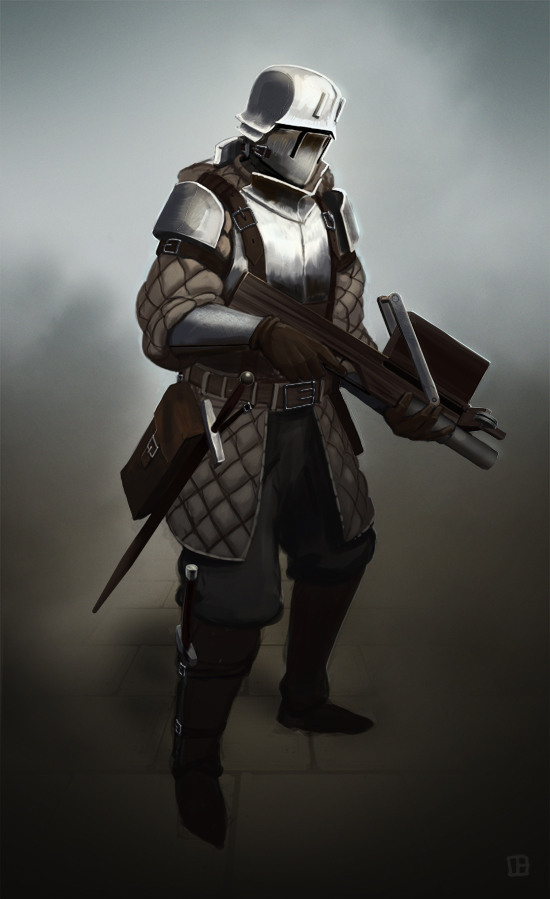
Royal Arsonist Corps
The Royal Arsonist Corps (RAC) was a a military branch that specialized in flamethrowers. The first flamethrowers were used in the Battle of Bridges where flame troopers prevented cavalry units from entering the battle by creating walls of fire. Flamethrowers became prominent during the First Desert War where both Lodona and the Eastern Republics used flamethrowers to rid trenchs of their soldiers by cooking them alive. Royal Commander Eugene Commerce was the founder of the Arsonist Corps. Though not as used as the Sentinels in the Royal Army, the RAC has made their reputation in skirmishes on the colony borders. In forests, jungles, and mountains, Arsonists would burn entire sections of wilderness to kill guerilla warriors. Lodona has used them to intimidate rebels in colonies by burning their leaders alive. Because of this, they have a nasty reputation even to Lodona. Honorable soldiers refuse to become Arsonists and thus the job mainly falls to impressed prisoners or criminals. The suits that Arsonists wore did not entirely protect the user from harmful gases that the flamethrowers create. Their lungs would be rotten up in just three years of service. This is known as the "Fire's Karma" and is believed to be a curse that the Arsonists must deal with for their terrifying actions in "humane" warfare.

The Royal Infantry AKA The Lodona Tide
The true backbone of the Royal Army, the Royal Infantry was such a vast army that it was dubbed "The Lodona Tide."
Royal Gunners
Royal Shock Troopers AKA "Hell Raisers"
By the second half of the Third Desert War, automatic weapons were popping up throughout the imperial armies. The Norselands were making submachine guns for their Valkyries, so to keep up with this, the Lodona Royal Engineers came up with their own machine guns that could be operated by one person. These "Hellbringer" submachine guns then led to the creation of the Shock Trooper Corps. The Shock Troopers had one mission: to charge and disrupt enemy strongholds. This task had been for the Sentinels before, but because of the advances in technology, the Sentinels were losing value. By the time of the revolution, they were mostly replaced with Shock Troopers and/or combinations of both. The Shock Troopers saw first use against the Norseland Valkyries in the colony of Requiem. They defeated the Valkyrie swarm and captured many of them and more importantly, putting themselves on top as the most dangerous stormtrooper type infantry. Their success and their weapons gave them the nickname "Hell Raisers" that they proudly wore on their uniforms. Their insignia became a lion with a flaming mane.
Hell Raisers were equipped with Hellbringer submachine guns, 2-5 heavy grenades, a pistol of their choice, and an anti-tank device of their choice. They wore no armor as they were specialized to carry as much fighting equipment as possible while still being able to sprint long distances. Hell Raisers endured intense training, even compared to Royal Guards. They were few in number, but they were certain to change the momentum against any foe, even the resilient Norseland Confederacy.
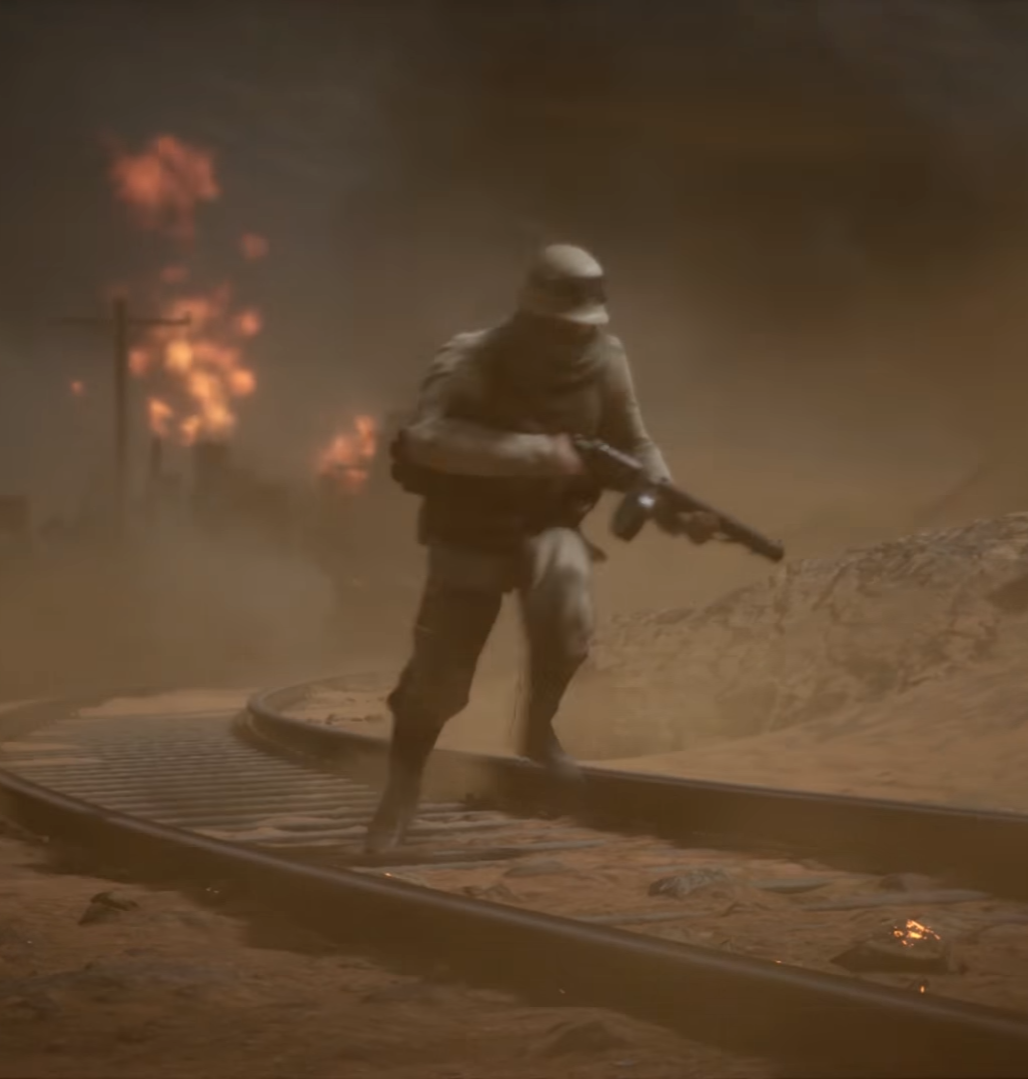
Hell Raiser in the Dread Desert during the small skirmishes between Lodona and the Eastern Republics by the time of the revolution.
Royal Dragoons
Although the name could mean cavalry, the Dragoon branch of military actually referred to the tanks and automobiles of war. They were first called "metal dragoons" when the first armored automobiles saw combat. "Dragoon" became the military term for drivers of these metallic beasts. Dragoons drove cars as well as tanks, but the tank drivers were also called "tankers."
The Royal Air Service
Royal Chemical Brigades
In the last year of the Second Desert War and throughout the Third Desert War, warfare was not only becoming heavily mechanized, but the rise of chemical warfare was spreading as well. Toxic gasses and acid started to see use. The Royal Army, always being on the cutting edge of technology, was not the first to use harmful gas, but was the first military to use it in mass quantities. When the Republican troops fortified themselves in the eastern parts of the Dread Desert, the Royal Army issued "Chemical Brigades" to gas them out of their pillboxes and trenches.
Royal Cavalry
Royal Artillery
Royal Officers and the Royal Constables/Police
Loyalist Volunteers
There was no such thing as a "Loyalist" before the revolution. The Loyalist faction only appeared when the revolution began. People of all classes ran in fear from the warmongering Nationalists in order to save themselves. Some men and women, which was a first for the Royals, volunteered themselves to serve the government forces for a very limited amount of time. Most enlisted for six months max. Volunteers were never given uniforms, but were instructed to wear anything white, so as to help the Royal Army identify them from the red Nationalists. The volunteers were handed a LSR and some ammunition. They were told to supply everything else. They then were placed in "militia regiments" and then commanded over by a Royal Officer. Up to 25,000 men and women became volunteers in the Loyalist armies. Though this may seem significant, it was underwhelming compared to the Nationalist Legion. They also lacked the Nationalist's fanaticism and thus were easily forced to retreat. Even with these volunteers, the Royal Army still did a tremendous amount of the fighting for the government.
Loyalist Noble Officers
Soon after the revolution began, nobles began to realize that the war may last longer than they anticipated. They had sent their maids, butlers, servants, and courtesans to fight as Volunteers and they still had yet to return. At this point, the moderates between the warring factions started to be forced to take sides. Lodona was being forced to pull the Royal Army from key colonies, losing them in the process to rivaling imperialists. The nobles realized that it would be suicide for Lodona if the motherland lost all of its child colonies, so they finally put down tea or crumpets to join the war as volunteers. However, unlike the working people that were enlisted as simple soldiers, the nobles could buy themselves ranks, even if they were noblewomen. Without any training, they became officers in the Loyalist Volunteer armies. Of course this was not good for the Loyalists as their leaders now were narcissistic nobles who did not care about their lives. However, several noblemen were actually veterans of war and could lead to some extent. Some nobles became loved generals in the revolution, but most were awful and only a few perished in the war they had entered.
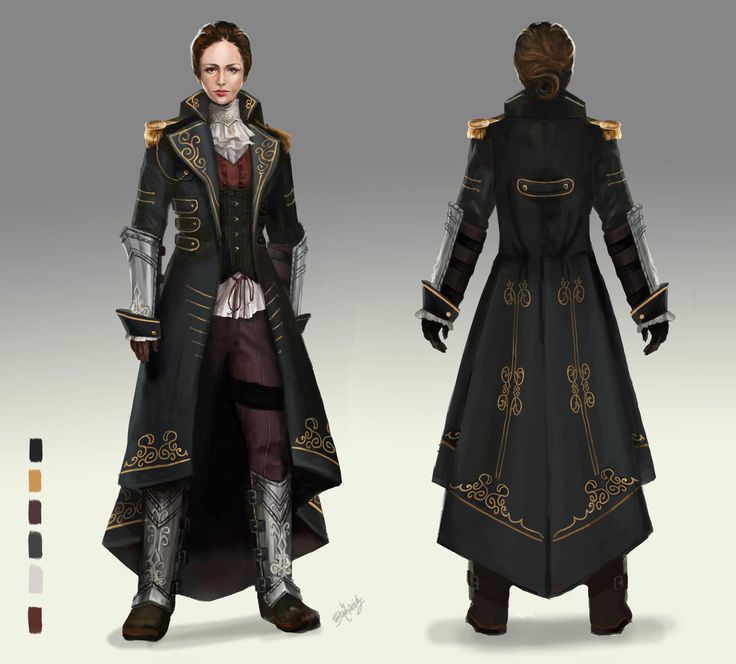
Loyalist Spies
Probably the most influential position of the Loyalists, the Spies were exceptionally vital in the revolution. The Blue Prince started up a spy ring for the Royals and placed Beatrice Bradshaw at the head of it. The Loyalist Spies were 60% women and most of them were plucked from the Volunteers. Lady Bradshaw trained them and instructed them on how to spy upon the Nationalists and Unionists. It was an incredible success and the main reason the Nationalists did not take Anastasia. The Spies helped find out who was supplying the rebels with guns and ammunition and who was commanding their forces. Because of the Spies, the Royal Army confronted the Norseland supply trains and fought Norseland mercenaries who were on their way to aid the Nationalists. One of the most notable Spies was Elysia Bell.
Nationalist Avengers
The Nationalist's version of the Royal Guard were the Avengers. The Avengers were Nationalist soldiers placed in Protector Exosuits created by Iris Sherwin, a Loyalist. Nationalists stole the design from her and captured her as well, forcing her to aid with the creation of more Protector Exosuits. Because of their early victories against the Loyalists, they were dubbed the "Avengers" by the people. Charles Valentine was impressed with these men and women who served in the exosuits and made them heroes for the people. Valentine even had his own Protector Exosuit created for himself. Avengers became huge threats to the Royal Army. Their suits did not have the protective qualities of the Royal Guard, but they had more freedom of movement and their armor was made of light alloys that allowed them to keep fighting even when tired. Their armor was also easily removed, making Avenger squads flexible and mobile on long distances. Iris Sherwin also designed them to be used quietly, so she made sure their armor did not rattle with movement. So it was hard to hear one coming unless one paid close attention. Their signature helmets became faces of demons to the Loyalists.
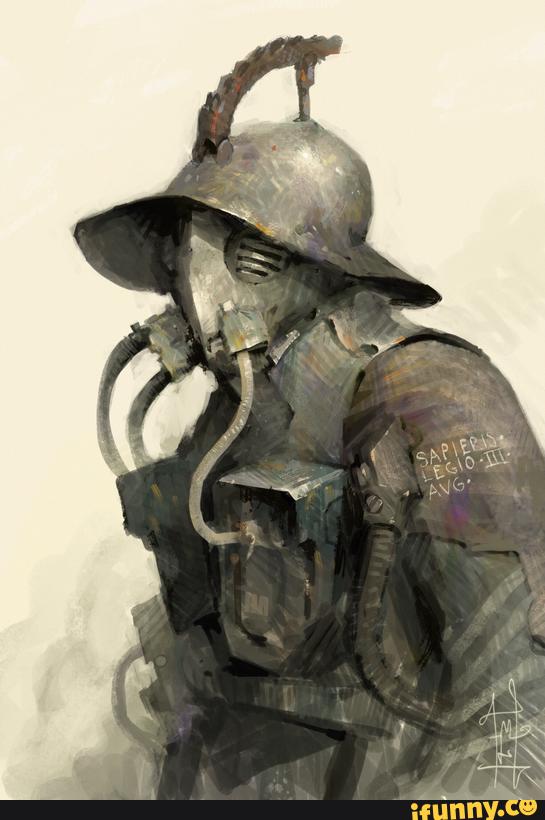
Nationalist's Crimson Legion
The Nationalist army, or the "Legion" as they called themselves, was the second largest army in the revolution, second, of course, to the Royal Army. Unlike their Unionist brothers, their army stretched all across the Lodona motherland. Their numbers swelled to 1.3 million troops by the peak of the revolution. Over 300,000 Nationalist Legionaries were in Anastasia, which vastly outnumbered the Loyalists and Royal Army in the Capital. They were led by Charles Valentine, a mysterious man that urged his troops to have no mercy for the government or those who would dare protect it. They were an organized army and not a rebellious mob like other revolutionary armies. Edward McBaine, a weapons dealer and financier of the Nationalists, helped in the creation of the Legion through mercenaries acquired from the Norselands and weapons from anywhere he could find them. Even before the revolution's start, Valentine and McBaine had been training men and women to fight. They knew it was going to be a prolonged war and not a quick overthrow of the Lodona government.
The Legion was composed of 85% men and 15% women, the highest concentration of women combatants in Lodona. To make sure their message was clear, they wore red clothes. They did have a uniform by the second year of the revolution, but the majority still did not possess the material to have a uniform. They refused to wear any yellow or blue so that they would not in any way look like the Lodona Royal Army. So most of the clothes Nationalists wore when they did not have the red uniforms were black or brown. Nationalists loved red so much that they would even use animal blood (as with the Royal Army stopping them from getting supplies like red dye) to stain their clothes.
Legionaries used weapons from every country in the world. Plenty of their weapons were beyond 50 years old. Even with McBaine heading the weapon finances, many Legionaries lacked ammunition or even guns. Those who did not possess weapons were told to take risks and scavenge battlefields for anything useful. They often did this during battles and were shot while in no-man's land or in Royal territory. Since they also were majority factory workers, they did not have many trained medics or doctors. Those that they did gain were deserters of the Royal Army, such as Dr. Timothy Wayne Turner. Because of this, most Nationalists died of disease from even the simplest of wounds. In Lodona's more wild parts, Nationalists constantly had problems gaining footholds as they would succumb to sickness while the Royal Army's prestigious healthcare systems kept their soldiers alive and well.
Despite all their disadvantages, the Nationalist Legion was a force to reckon with. They were resourceful and fanatical. No where in the world was there a more unified force. Men and women from less-than-humble beginnings took up arms and became warriors against the government. Though it was clear they understood nothing about actual "freedom" they still fought to better their and their family's lives.
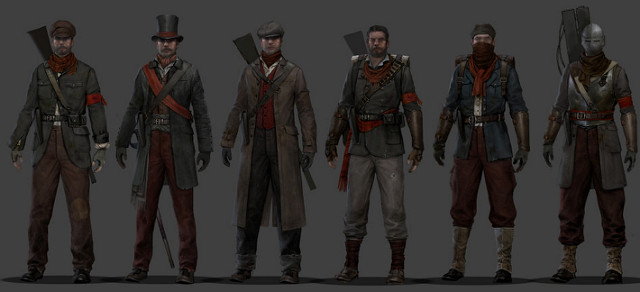
Nationalist Hell Hounds
With the sudden rise of armored automobiles, some thought it would be a great idea to use them as hit-and-run flamethrower units. Nationalists, using modified C-2 Whiterunners with a mounted flamethrower, began to race through the streets, sending the vile flames into anything they drove passed. They soon earned the name "Hell Hounds." There was never many of these modified automobiles as most remained in their standard form, retaining range and suppression. The Hell Hounds tried to see combat outside of Anastasia, but the open fields made them easy targets. Being in gas operated vehicles tossing flames out from the roof also made working in them quite dangerous. Almost a quarter of Hell Hounds ended up destroying themselves.
Nationalist Pursuers
The only real airborne branch of military that the Nationalist's possessed, the Pursuers were a terrifying bunch of daredevil pilots that took to the sky to rain death upon Loyalists below. Their pilots were all previously commercial pilots of zeppelins, airships, or air delivery transports. Not being able to make their own planes of war, they simply added guns to their delivery planes. The pilot squads were led by Elizabeth Daniel, who also acted as a spy. Lady Daniel was a skilled delivery pilot before the revolution began, and thus she was the best Pursuer that Nationalists had. The Pursuers used their bi-planes to hunt down RAS fighters or bombers. Not being as well-equipped as their Royal counterparts, they were often demolished by the aerial aces of the Royal Air Service. However, they did make an impact on the war when the Norseland Confederacy began to supply them with better equipment and better planes. The Norseland planes were some of the best in the world and turned the tables on the RAS. Now Pursuers could track down enemy bombers and shoot them down or they could even disable enemy planes and salvage the parts for their own benefit. The Nationalists never had a proper airforce, but the Pursuers tried to fill the whole with their laughably small numbers.
Nationalist Watchers
The Watchers as they were called by Loyalists was a small group of Nationalist women spies that worked for Arthur Daniel. There is no knowledge of how many there were, but it is reasonable to suggest there was less than 30. The Watchers were Nationalists that could infiltrate Loyalist positions and even find a way to the other side of the White Wall. Chief among these spies was Eliz Daniel, the young wife of Master Daniel. Serving mainly as a pilot in the revolution, she also acted as a spy. She and the Watchers would steal Royal documents, poison officers, and perform various acts of espionage. Their impact was not the largest on the revolution, but in Anastasia, they did make their name known. Six Watchers were executed by the Royal Guards, which seemed to have halted many Watcher plans, as their activity dwindled beyond this point. This is the main reason why it is thought that there were very few of them to begin with.
Union Party Soldiers
When Sabrina Garner took over the Unionist Party, she brought the Nationalist's violent tendencies with her. Unlike Isaac Benjamin, who simply wanted protection and better working environments for factories, Garner wanted the destruction of the current economy and government and it be replaced by a more equal society. Her soldiers were all factory workers, untrained and undisciplined. Unlike the Nationalists, who had both mercenaries from the Norselands and weapon dealers, Garner's forces had nothing but the factories and were not in large numbers as some workers turned into Loyalists. The Unionist army, which was called the Worker's Brigade, was the smallest army in the revolution, topping at 4,500 soldiers. These men and women, who most had never used a gun before, were armed with Garner Experimental Rifles, well, if they were lucky to get one. Most stole and scavenged for surplus rifles left behind from the many Lodona wars. They were purple homemade vests that symbolized their true "royalty" and Garner's leadership. Garner proclaimed herself chief of the army, but she never participated in the battles they had in Anastasia. The Unionist soldiers were often just armed gangs that patrolled the Capital, looking for a fight. They saw roughly 15% of the battles in the Lodona Revolution and only had 2 accounted victories against Loyalist troops or the Royal Army.
Union Party Operators
In the small army of 4,500, there was a small sect that became known as the Operators. They were a group of 200 Unionist soldiers led by Nigel Jerryson, a former friend of Isaac Benjamin. Because of their lives being spent in steel factories, these Operators were skilled in mechanics and understood how the metal beasts of war operated. Jerryson, soon after the revolution had begun, spoke with Sabrina Garner on the issue that the Royal Army could bring the tanks and landships of war upon them. He wanted to create a group of their best warriors to be equipped with the sole purpose of sabotaging vehicles and scrapping metal for their factories. Garner gave him her permission and the Operators were born. These 200, of which 187 died in the revolution, including Jerryson, were the biggest threat to the Royal Army that the Unionists ever brought up to the table. They would often be in enemy territory, scouting out for tank brigades in or outside of Anastasia. With their tools and expertise, they would dismantle or break engines, tracks, or guns. They rarely fought themselves and were told to give up on sight if caught by Royals. The order did not work as they were quite often shot before they could surrender. During the revolution, they disabled 130 vehicles.
Republican People's Army
In the Orient Lands, there is an empire that used to be comprised of hundreds of individual nations. Hanshiro the Harbinger conquered one small nation at a time until they were all under one leader. It was then that it became the Republics of the East Orient. Because of their separate cultures all being mashed into one, they formed a unique language that combined the languages of old. Hanshiro was a master of uniting people, especially conquered people. Instead of forcing the conquered nations to be just like his, he decided to have them all assimilate into one massive culture that was founded upon their similarities rather than their differences.
The People's Army is the largest fighting force in the world. Their numbers triple the fighting force of the Norseland (including its colony forces) and almost double the forces of Lodona. There are two reasons for this: The Eastern Republics are the largest nation in terms of land and men of the age of 17 are required to enlist in the army. Because every boy has to be trained according to the law, women in the Republic are the actual governing sex. The Republics contain representatives from every state, called "jotai's" which are dominated by females and they represent their jotai's to the Central Government, which is led by a 101 men and women and a Great Omo, which is the true ruler of the land.
The People's Army have never had the best technology compared to their imperialist rivals. Their success as a nation comes from their unity and their aggressive strategies. As they began to industrialize, they stretched their borders slowly, gaining grounds in places they thought they didn't need before. Every new colony/nation under their control had to also make their young men enlist in the army, thus any men they lost in their conquests were quickly replaced.
Equipment for the People's Army was not as scarce as would be believed. The factories of the Eastern Republics were stretched throughout the whole nation. Women tirelessly worked in the steel mills and the forges to create every weapon and bullet they could. Every soldier was handed a helmet, a breastplate, a tanto, a stick grenade, a standard rifle, and 20 rounds. This was minimal compared to the equipment used by the Royal Army, but it was sufficient for a new recruit in war.
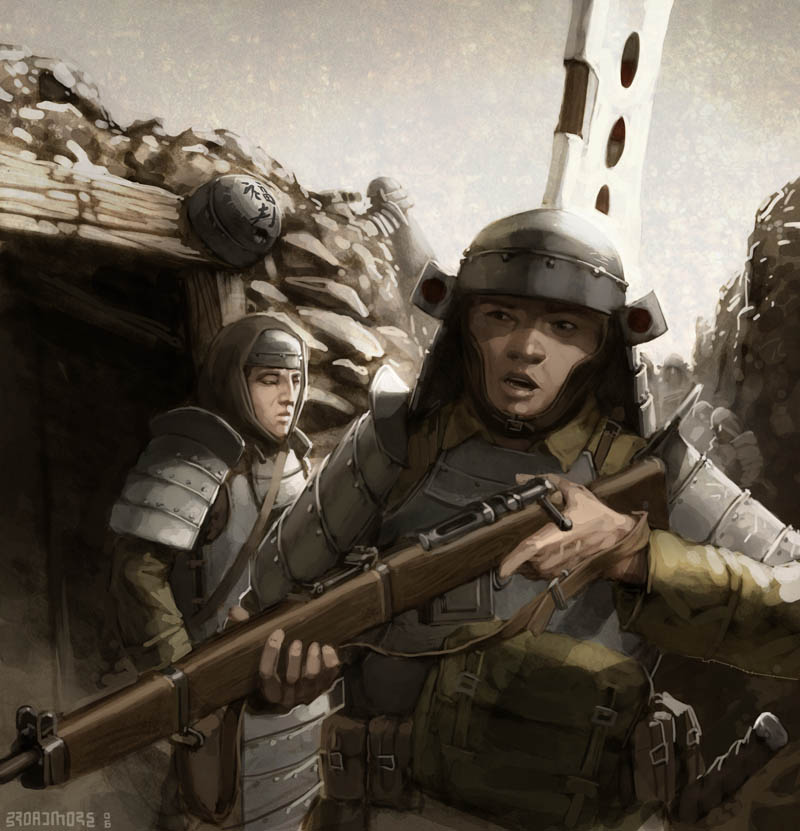
Republican Guardians
The Guardians were a military branch that appeared during the Desert Wars due to being cut off by Lodona adavnces into Republican territory. At first, they were simple infantrymen who survived on their own, but by the Third Desert War, they were a special forces unit that operated behind enemy lines within the sand dunes of the Dread Desert.
Republican Sky Dragons
Republican Iron Samurai
In the Age of Industry, there was a race to see who could create the best "armored infantry" in the wars. The Norseland created the Valkyries and the Zealots, the Lodona Empire made Sentinels and the Royal Guards, the Makri made Prowlers, and the Republics made Iron Samurais. The Iron Samurai, often referred to as "The Iron Hand of the Great Omo" were brilliantly designed exo-suits that ran on steam. Unlike the Sentinels and Royal Guards, who used massive steel plates as armor, the Iron Samurai used several thinner plates and folded each layer over the other like a stack of paper. It proved to be reliable enough as bullet-resistant armor to be used in combat. Most of the Iron Samurai, like the Royal Guard, stayed back to protect the homeland, but many made their way to the Dread Desert to fight the imperials in the Desert Wars. They were truly frightening to the Royal Army, who saw them as metal monsters waving swords about and firing large guns. Their impact on the war was not as much as their counterpart Sentinels, but their presence alone brought fear to the enemy.
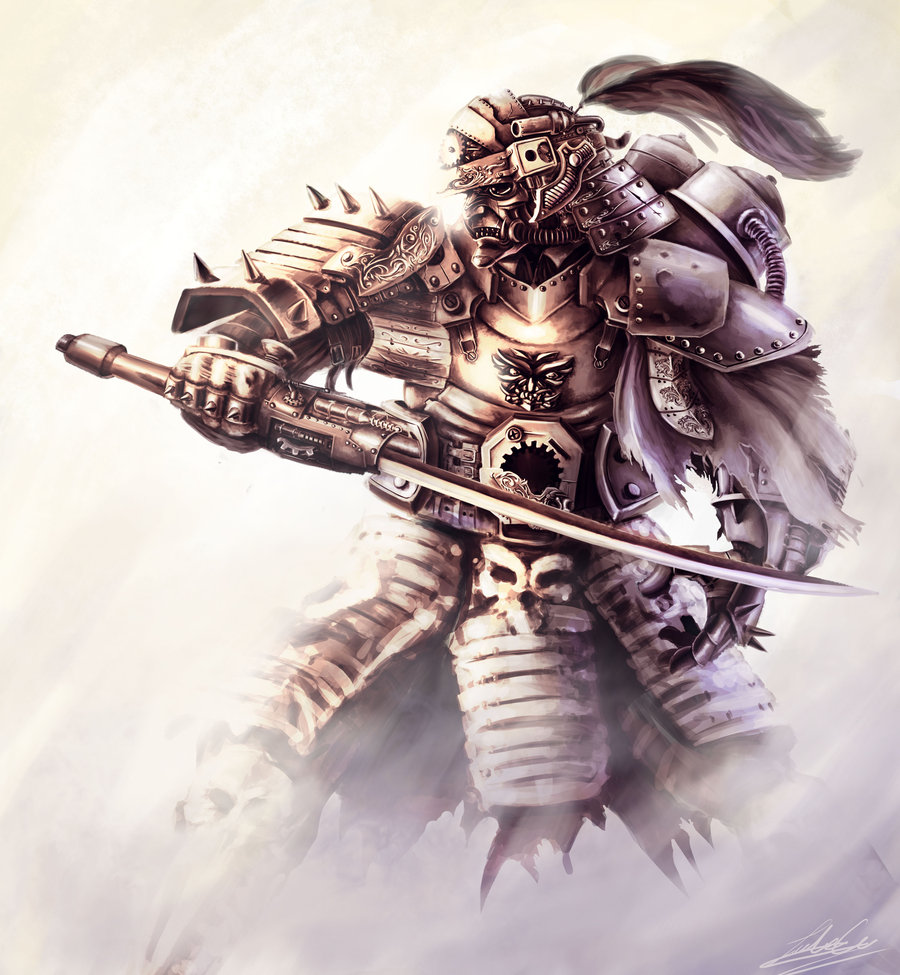
Army of the Seven Lords
North of the Forgone Mountains is a nation of seven different countries. This is the Norseland Confederacy. Norseland is a imperial nation that is ruled by the Seven Lords, who each rule their own country. Although these countries are called countries, they more resemble states. The Norseland Confederacy started as a true confederate state, but with time they evolved to a more federalist union, but kept the name.
The Army of the Seven Lords was one of the most advanced armies in the world.
Norseland Pirates
Norseland Pillagers
Norseland Raiders
The Raiders of the Norseland were the standard infantrymen. They were called "Raiders" from their early years of sacking nearby cities for the glory of the Seven Lords, otherwise, they do not connect to their name at all in modern times. The Raiders were the backbone of the Norseland military, always enduring extreme temperatures and extreme environments such as the Forgone Mountains.
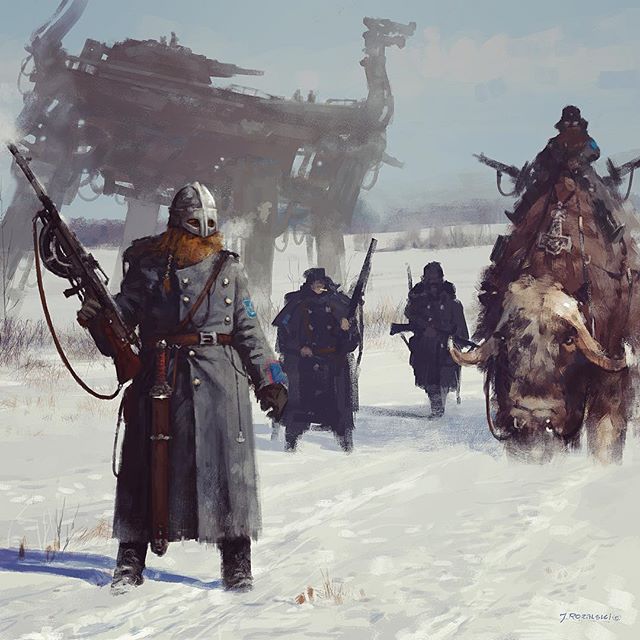
Norseland Zealots
Norseland Valkyries
The Valkyries were a women-only military branch. They served much like regular infantry, but possessed light armor and acted as shock troopers in the mountains. They were founded by Anette Tordis the First Valkyrie. Tordis demanded that the Seven Lords would allow women to enlist in the Norseland Army. Six of the Seven agreed to grant her her wish. The Valkyries were created and thousands of women enlisted into the program to aid their glorious empire. The first battle they fought in was the Battle of Wings where the Norseland Confederacy faced the forces of the Colonial Forces of the Lodona Requiem Colony. It was a huge victory for the Confederacy and the Valkyries led the charges against the enemy. Because of their success, the Seven Lords decided to invest into the Valkyries, improving their weapons and gadgets. Their armor was improved, being only slightly based off the Steam-powered suits of the Royal Guards. They received small automatic weapons for charging masses of infantry and were given Ragnarok Rifles for medium-long range. Because of the Confederate ferocity and brutal tactics, these women became a feared force in the world of imperial nations fighting for every inch of ground. By the time of the Lodona revolution, the Valkyries made up 20% of the Confederate military. They were the largest woman force ever created.
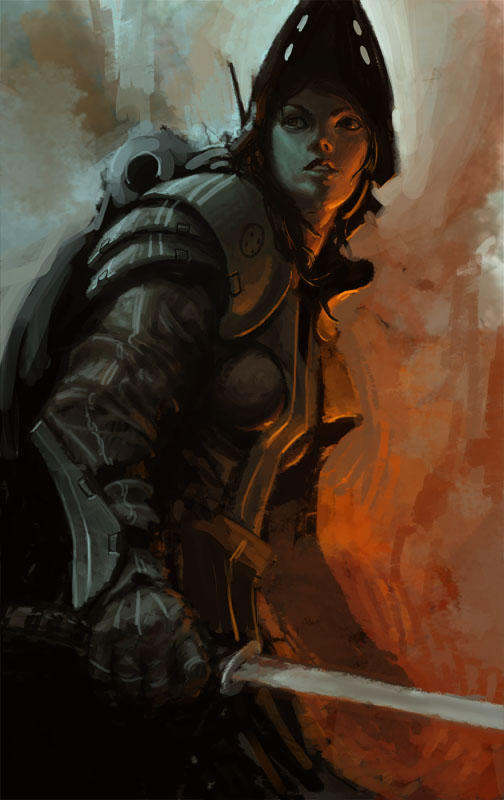
Wastelander Scout
The men and women of the Dread Deserts were called "Wastelanders." Before Abigail Arklight took over as their Governess, they were simple oil/diamond traders. After the First Desert War between Lodona and the Eastern Republics, Governess Arklight concluded that they would need a protecting force, as both of the imperial beasts would never let their home be peaceful. She, with the help of mercenaries from the Norselands, trained a military force to become some sort of national guard. They were called Scouts. Because they would never match the numbers of the imperials, they were trained in guerrilla warfare and desert survival. They were scavengers of battlefields by the imperials, picking up weapons and supplies from dead soldiers. They were never to engage with battling imperials and only were assigned to protect Wastelander villages or to ward off imperials if they encroach on peaceful lands. They used a variety of weapons, including Destroyer Rifles and LSRs. If it could help, they would use it. They even sometimes captured armored vehicles to store in their desert villages.
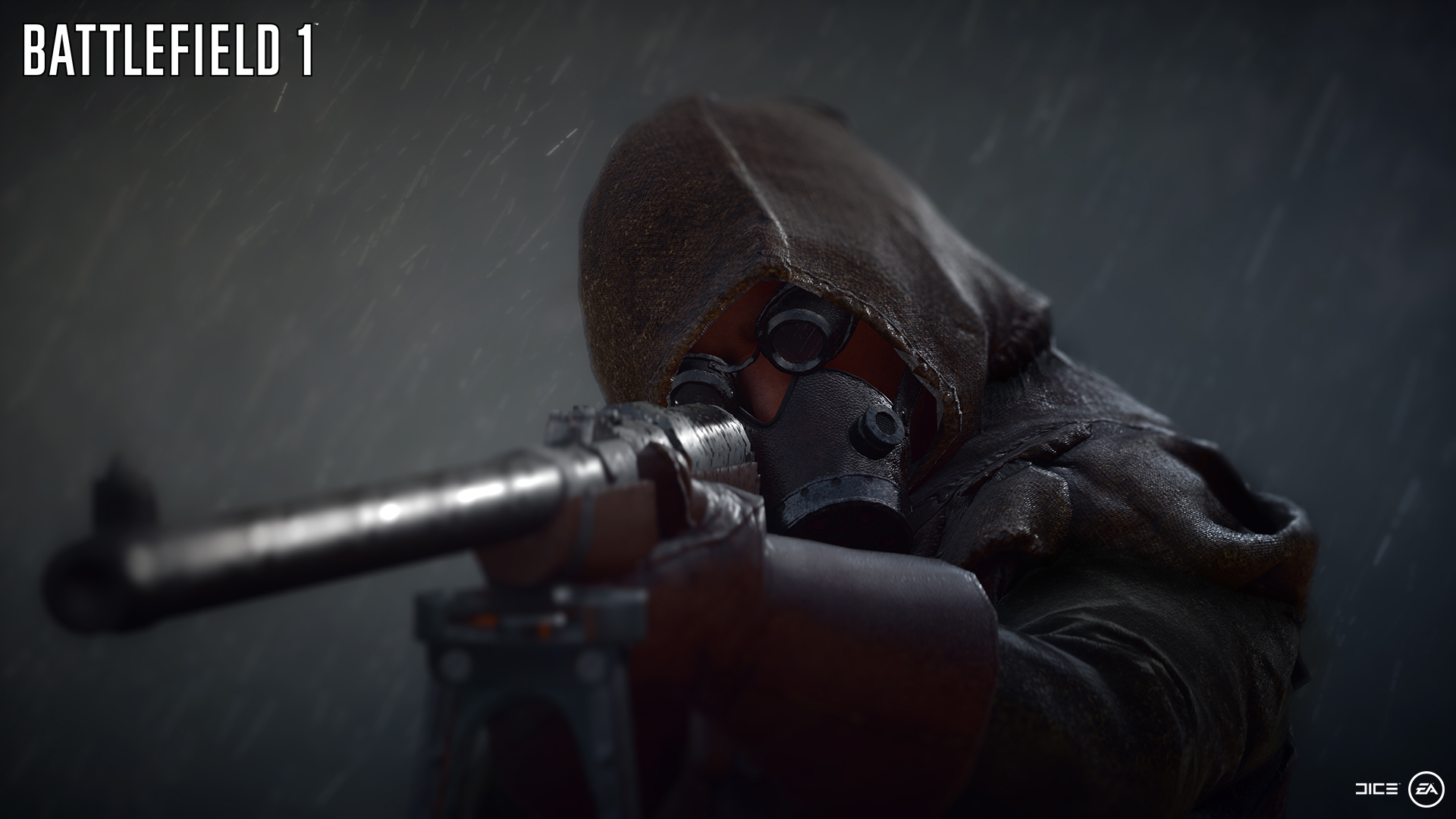
Makri Striders
Makri Prowlers
